Transforming Construction Waste into High-Performance Alkali-Activated Paste with Microstructural and Predictive π Modelling Insights
Abstract
1. Introduction
| CDW Type | Additive | Optimal Conditions | Activator | Strength (MPa) | Application | References |
|---|---|---|---|---|---|---|
| Mixed CDW | None | 25 °C, 60 days, AAS100% a (undiluted) | NaOH + Na2SiO3 | UCS: 4 Tensile: 0.8 | Base/Subbase Pavement Layers | [43] |
| Recycled Concrete | None | 25 °C, 28 days AAS100% (undiluted) | NaOH + Na2SiO3 | UCS: 0.2 Flexural: 0.1 | Base/Subbase Pavement Layers | [44] |
| Recycled Asphalt | UCS: 7.9 Flexural: 4.5 | |||||
| Brick and Tiles | UCS: 2.1 Flexural: 0.5 | |||||
| Unselected Aggregates | UCS: 12.8 Flexural: 4.9 | |||||
| Crushed Brick | FA b | 25 °C, 7 days Si/Na = 2.5, (16% FA) | NaOH + Na2SiO3 | UCS: 1.2 | Base/Subbase Pavement Layers | [45] |
| Recycled Concrete Aggregates | UCS: 2.1 | |||||
| Reclaimed Asphalt Pavement | UCS: 2.0 | |||||
| Mixed CDW | None | 39 °C, 21 days 10 M NaOH | NaOH, KOH, CaO | Bearing Capacity: 568 kPa | Soil Improvement | [46] |
| Brick Waste | None | 40–50 °C, 28 days RH ≈ 59% | Lime Residue, NaOH | UCS: 1.7–2.3× vs. non-stabilised. | Soil Stabilization | [36] |
| Mixed CDW | 10% OPC c | 25 °C, RH ≈ 80%, 90 days, Si/Na = 0.34 | NaOH + Na2SiO3 | UCS: 44 MPa | Binder, Concrete, Structural Blocks | [47] |
| Ceramic Tile Wastes | 15% OPC | 25 °C, 90 days, Si/Al = 7.0, Na/Si = 0.08 | NaOH + Na2SiO3 | UCS: 58 MPa (paste, 28 days) | Binder and Mortars | [48] |
| UCS: 30 MPa (mortar, 90 days) | ||||||
| Ceramic Tile Waste | 5% Ca (OH)2 | 65 °C, 7 days, RH ≈ 95%, w/b = 0.50 | NaOH + Na2SiO3 | UCS: 43 MPa (3 days at 65 °C) | Binder and Mortars | [33] |
| Mixed CDW (Concrete, Ceramic, Masonry) | 10% OPC/Ca(OH)2 | 25 °C Na/Si = 0.25 L/S = 0.30 | NaOH + Na2SiO3 | UCS: 32 MPa (90 days at 25 °C) | Hybrid Cement | [49] |
| Brick Powder | FA | 21 °C, 90 days Si/Na = 1.6 | NaOH + Na2SiO3 | UCS: 70 MPa | Binder | [50] |
| Brick Powder and Ceramic Sand | GGBFS d (0–50%) | 25 °C,56 days 95% RH, Si/Na = 1.5 | NaOH + Na2SiO3 | UCS: 93 MPa | Mortar/Concrete Applications | [51] |
| Concrete Waste | None | 90 °C, 7 days NaOH (14 M) | NaOH | UCS: 13 MPa | Insulating Materials/Coatings | [52] |
| Brick Waste | 90 °C, 7 days, NaOH (8 M) | UCS: 49 MPa | Insulating Materials/Coatings | |||
| Tile Waste | 80 °C, 7 days NaOH (10 M) | UCS: 58 MPa | Limited Structural Use | |||
| Waste red Brick | FA + GGBFS | 25 °C & RH = 65%, L/B = 0.45, Si/Na = 1.1 | NaOH + Na2SiO3 | UCS: 70 MPa | High-Strength Paste Applications | [53] |
| Waste Ceramic | FA + GGBFS | 25 °C & RH = 65%, L/B = 0.45, Si/Na = 1.2 | NaOH + Na2SiO3 | UCS: 60 MPa | High-Strength Paste Applications |
2. Research Framework
3. Materials and Methods
3.1. Materials
3.2. Preparation and Moulding
3.2.1. Preparation of Alkaline Solution
3.2.2. Preparation of Mortar Blends
3.2.3. Curing of Mortar Blends
3.2.4. Experimental Regime of AAP Blends
3.3. Methods
3.3.1. Unconfined Compressive Strength
3.3.2. Ultrasonic Pulse Velocity
3.3.3. Wet and Dry Durability
3.3.4. Freeze and Thaw Durability
4. Results and Discussion
4.1. Unconfined Compressive Strength
4.1.1. Influence of Activator Dosage, Curing Regime and Binder Composition on AAP Strength
4.1.2. Empirical Unconfined Compressive Strength Prediction Equation Development
4.1.3. Generalised Strength Prediction Modelling Using Dimensional Analysis
4.2. Stiffness/Initial Shear Modulus
4.2.1. Influence of Alkali Content, Curing Duration, and Binder Composition on AAP Stiffness
4.2.2. Empirical Stiffness Prediction Equation Development
4.2.3. Shear Modulus Prediction Modelling Using Logarithmic Regression
4.3. Effect of NaOH Concentration, Curing and CDW Composition on AAPs Freeze and Thaw Resistance
4.4. Effect of NaOH Concentration, Curing and CDW Composition on AAP Wet and Dry Resistance
4.5. Statistical Significance of Mix Design Parameters
- NaOH Concentration: This is the most effective parameter for enhancing both strength and durability.
- BW/TW Ratio: It must be selected carefully, particularly in conjunction with NaOH, to maximise strength. This is evidenced by the significant interaction between these two factors.
- Curing Age: This factor plays a crucial role in enhancing stiffness, contributing more significantly than it does for strength.
- Composition: The influence of composition becomes more pronounced under freeze–thaw conditions. This highlights the necessity for implementing gel densification strategies when exposure to such cycles is anticipated.
4.6. Microstructural Analysis
4.6.1. X-Ray Diffraction (XRD)
4.6.2. Scanning Electron Microscope (SEM)
5. Conclusions
- High Mechanical Performance: Compressive strength increased significantly with NaOH concentration, reaching 29 MPa at 10% NaOH, a BW/TW ratio of 0.9, and a curing period of 60 days. This represents a more than 2100% improvement compared to untreated samples, which had a strength of 1.3 MPa.
- Strength Behaviour: The compressive strength followed a power-law relationship with recycled brick content, driven by an increase in reactive surface area and enhanced gel formation. The NaOH content exhibited a linear effect on strength, resulting from proportional increases in precursor dissolution.
- Parameter Correlations: Correlation analysis revealed that the recycled brick content significantly enhanced the strength (R = 0.77), whereas the recycled concrete content reduced it (R = −0.77). NaOH had a moderate positive effect, and curing time had the least influence.
- Stiffness Gains: The shear modulus increased with NaOH concentration across all BW/TW ratios and curing periods. After 60 days with a BW/TW ratio of 0.9, Go reached 21, 23, and 30 GPa for 5%, 7%, and 10% NaOH, respectively, confirming enhanced stiffness with stronger activation.
- Influence of Recycled Brick on Stiffness: The recycled brick content produced modest gains in stiffness at lower ratios (0.11–0.25) but substantial increases at higher ratios (4.0–9.0) across all NaOH levels and curing times.
- Freeze–Thaw Durability: Control mixes failed within 2–4 cycles due to the absence of alkali activation. In contrast, AAPs completed all 12 cycles with significantly reduced ALM. The lowest ALM, 2.6%, occurred with 10% NaOH.
- Wet–Dry Durability: Control mixes degraded rapidly (ALM 20–35%) and failed within 2–5 cycles. Conversely, AAPs completed all 12 cycles with an ALM as low as 1.96% at 10% NaOH.
- Microstructural Evolution: XRD analysis confirmed the progressive mineralogical transformations that occurred with increasing NaOH content, particularly at a BW/TW ratio of 0.9. The formation of N-A-S-H and C-A-S-H phases, along with sharper peaks at 10% NaOH, indicates improved structural integrity and long-term stability. Principal component analysis of XRD data revealed distinct clustering based on curing time and NaOH content. High-alkali, long-cured samples exhibited advanced phase development, with Sample 8 (10% NaOH, 60 days) showing the greatest crystallinity.
- Microstructural Densification: SEM images revealed that 10% NaOH resulted in the most crystalline and dense matrix, characterised by abundant needle-like and columnar phases, indicative of advanced geopolymerization. Such an aspect correlates with enhanced mechanical strength and durability.
- Limitations and Future Work: This study demonstrates the feasibility of producing binder-free alkali-activated pastes from CDW fines, showing promising mechanical and durability properties. However, several limitations should be considered. The number of tested specimens, particularly for durability assessments, was limited, which may affect the statistical reliability of the results. Furthermore, advanced characterisation methods, such as Thermogravimetric Analysis (TGA) and energy-dispersive X-ray spectroscopy (EDS), can provide deeper insights into the reaction mechanisms and the evolution of the gel. Additionally, the performance and long-term durability of these materials in real environmental conditions still need to be validated. Future research should focus on these aspects to enhance the applicability of the findings and facilitate their transition from laboratory settings to large-scale implementation.
Author Contributions
Funding
Data Availability Statement
Conflicts of Interest
List of Notations and Abbreviations
| AAC | Alkali-Activated Concrete |
| AAMs | Alkali-Activated Mortars |
| AAPs | Alkali-Activated Paste |
| AAS | Alkali-Activated Solution |
| ALM | Accumulated Mass Loss |
| BFS | Blast Furnace Slag |
| BW | Brick Waste |
| CDW | Construction and Demolition Waste |
| CW | Concrete Waste |
| DA | Dimensional Analysis |
| FA | Fly Ash |
| GGBFS | Ground Granulated Blast Furnace Slag |
| MSW | Municipal Solid Waste |
| NaOH | Sodium Hydroxide |
| OPC | Ordinary Portland Cement |
| RH | Relative Humidity |
| SCM | Supplementary Cementitious Material |
| SEM | Scanning Electron Microscopy |
| TW | Total Waste |
| UCS | Unconfined Compressive Strength |
| UPV | Ultrasonic Pulse Velocity |
| XRD | X-ray Diffraction |
| XRF | X-ray Fluorescence |
| C-A-S-H | Calcium Aluminosilicate Hydrate |
| C-S-H | Calcium Silicate Hydrate |
| N-A-S-H | Sodium Aluminosilicate Hydrate |
| BW/CW | Brick Waste-to-Concrete Waste Ratio |
| BW/TW | Brick Waste-to-Total Waste Ratio |
| F/T | Freeze–Thaw |
| W/D | Wet–Dry |
| Go | Initial Shear Modulus |
| Vs | Shear Wave Velocity |
| ρ | Density |
Appendix A
| Specimen | NaOH Content | UCSmean | Variance | Standard Deviation | Go,mean | Variance | Standard Deviation |
|---|---|---|---|---|---|---|---|
| BW: Brick Waste | |||||||
| CW: Concrete Waste | (MPa) | (GPa) | (GPa) | (GPa) | |||
| 00BW, 100CW | 0% NaOH | 0.477 | 0.000 | 0.013 | 0.252 | 0.00036 | 0.001 |
| 10BW, 90CW | 0.814 | 0.004 | 0.062 | 0.288 | 0.00003 | 0.000 | |
| 20BW, 80CW | 0.542 | 0.001 | 0.027 | 0.328 | 0.00003 | 0.000 | |
| 30BW, 70CW | 0.605 | 0.002 | 0.039 | 0.352 | 0.00014 | 0.000 | |
| 40BW, 60CW | 0.645 | 0.000 | 0.013 | 0.376 | 0.00228 | 0.005 | |
| 50BW, 50CW | 0.684 | 0.000 | 0.016 | 0.406 | 0.00010 | 0.000 | |
| 60BW, 40CW | 0.712 | 0.000 | 0.021 | 0.456 | 0.00000 | 0.000 | |
| 70BW, 30CW | 0.742 | 0.000 | 0.002 | 0.519 | 0.00005 | 0.000 | |
| 80BW, 20CW | 0.752 | 0.000 | 0.001 | 0.620 | 0.00039 | 0.001 | |
| 90BW, 10CW | 0.805 | 0.005 | 0.071 | 0.673 | 0.00003 | 0.000 | |
| 100BW, 00CW | 0.92 | 0.000 | 0.003 | 0.575 | 0.00001 | 0.000 | |
| 00BW, 100CW | 5% NaOH | 1.969 | 0.006 | 0.077 | 2.158 | 0.00718 | 0.014 |
| 10BW, 90CW | 8.39 | 0.036 | 0.19 | 2.351 | 0.00104 | 0.002 | |
| 20BW, 80CW | 2.577 | 0.017 | 0.131 | 2.618 | 0.01400 | 0.028 | |
| 30BW, 70CW | 3.351 | 0.025 | 0.159 | 3.306 | 0.00071 | 0.001 | |
| 40BW, 60CW | 4.316 | 0.003 | 0.051 | 3.735 | 0.00515 | 0.010 | |
| 50BW, 50CW | 5.344 | 0.036 | 0.189 | 4.227 | 0.00829 | 0.017 | |
| 60BW, 40CW | 5.866 | 0.636 | 0.798 | 4.594 | 0.01949 | 0.039 | |
| 70BW, 30CW | 6.846 | 0.341 | 0.584 | 5.399 | 0.00025 | 0.000 | |
| 80BW, 20CW | 7.874 | 1.426 | 1.194 | 5.991 | 0.00033 | 0.001 | |
| 90BW, 10CW | 9.028 | 2.010 | 1.418 | 6.489 | 0.01187 | 0.024 | |
| 100BW, 00CW | 10.12 | 0.016 | 0.127 | 5.362 | 0.00260 | 0.005 | |
| 00BW, 100CW | 7% NaOH | 2.838 | 0.001 | 0.027 | 2.670 | 0.00535 | 0.011 |
| 10BW, 90CW | 10.131 | 0.044 | 0.209 | 3.107 | 0.01728 | 0.035 | |
| 20BW, 80CW | 3.394 | 0.135 | 0.368 | 3.720 | 0.01644 | 0.033 | |
| 30BW, 70CW | 4.099 | 0.003 | 0.057 | 4.357 | 0.00917 | 0.018 | |
| 40BW, 60CW | 5.096 | 0.024 | 0.156 | 5.558 | 0.00061 | 0.001 | |
| 50BW, 50CW | 6.626 | 0.000 | 0.005 | 6.346 | 0.02410 | 0.048 | |
| 60BW, 40CW | 6.592 | 0.948 | 0.974 | 7.435 | 0.00778 | 0.016 | |
| 70BW, 30CW | 7.539 | 0.010 | 0.1 | 8.627 | 0.01408 | 0.028 | |
| 80BW, 20CW | 8.721 | 0.008 | 0.09 | 9.685 | 0.09202 | 0.184 | |
| 90BW, 10CW | 9.832 | 0.300 | 0.547 | 10.694 | 0.06011 | 0.120 | |
| 100BW, 00CW | 11.843 | 0.270 | 0.52 | 9.244 | 0.03510 | 0.070 | |
| 00BW, 100CW | 10% NaOH | 4.429 | 0.528 | 0.727 | 5.393 | 0.02648 | 0.053 |
| 10BW, 90CW | 14.014 | 1.502 | 1.225 | 6.323 | 0.00129 | 0.003 | |
| 20BW, 80CW | 5.076 | 6.255 | 2.501 | 7.211 | 0.11532 | 0.231 | |
| 30BW, 70CW | 6.014 | 2.331 | 1.527 | 8.572 | 0.00531 | 0.011 | |
| 40BW, 60CW | 8.642 | 0.501 | 0.708 | 9.811 | 0.04916 | 0.098 | |
| 50BW, 50CW | 9.668 | 0.022 | 0.148 | 11.350 | 0.01256 | 0.025 | |
| 60BW, 40CW | 10.73 | 0.088 | 0.297 | 12.831 | 0.08283 | 0.166 | |
| 70BW, 30CW | 11.483 | 0.033 | 0.181 | 14.016 | 0.03379 | 0.068 | |
| 80BW, 20CW | 13.71 | 0.037 | 0.192 | 15.422 | 0.00956 | 0.019 | |
| 90BW, 10CW | 14.401 | 3.495 | 1.87 | 17.051 | 0.27398 | 0.548 | |
| 100BW, 00CW | 16.696 | 1.373 | 1.172 | 14.972 | 0.02988 | 0.060 |
| Specimen | NaOH Content | UCSmean | Variance | Standard Deviation | Go,mean | Variance | Standard Deviation |
|---|---|---|---|---|---|---|---|
| BW: Brick Waste | |||||||
| CW: Concrete Waste | (MPa) | (GPa) | (GPa) | (GPa) | |||
| 00BW, 100CW | 0% NaOH | 0.516 | 0.020 | 0.141 | 0.519 | 0.00006 | 0.000 |
| 10BW, 90CW | 0.843 | 0.005 | 0.068 | 0.611 | 0.00001 | 0.000 | |
| 20BW, 80CW | 0.692 | 0.000 | 0.006 | 0.663 | 0.00010 | 0.000 | |
| 30BW, 70CW | 0.776 | 0.000 | 0.016 | 0.713 | 0.00015 | 0.000 | |
| 40BW, 60CW | 0.828 | 0.000 | 0.012 | 0.769 | 0.00014 | 0.000 | |
| 50BW, 50CW | 0.877 | 0.001 | 0.025 | 0.817 | 0.00001 | 0.000 | |
| 60BW, 40CW | 0.922 | 0.001 | 0.025 | 0.854 | 0.00000 | 0.000 | |
| 70BW, 30CW | 0.954 | 0.000 | 0.020 | 0.927 | 0.00000 | 0.000 | |
| 80BW, 20CW | 1.008 | 0.003 | 0.058 | 1.003 | 0.00002 | 0.000 | |
| 90BW, 10CW | 1.032 | 0.010 | 0.101 | 1.098 | 0.00001 | 0.000 | |
| 100BW, 00CW | 1.042 | 0.010 | 0.102 | 0.976 | 0.00474 | 0.009 | |
| 00BW, 100CW | 5% NaOH | 2.170 | 0.011 | 0.107 | 7.453 | 0.00000 | 0.000 |
| 10BW, 90CW | 10.384 | 0.003 | 0.054 | 8.326 | 0.05164 | 0.103 | |
| 20BW, 80CW | 3.313 | 0.003 | 0.058 | 9.463 | 0.00001 | 0.000 | |
| 30BW, 70CW | 4.007 | 0.064 | 0.253 | 10.462 | 0.14544 | 0.291 | |
| 40BW, 60CW | 5.284 | 0.056 | 0.237 | 11.265 | 0.00784 | 0.016 | |
| 50BW, 50CW | 5.583 | 0.054 | 0.233 | 12.557 | 0.15481 | 0.310 | |
| 60BW, 40CW | 6.570 | 0.563 | 0.750 | 14.083 | 0.18153 | 0.363 | |
| 70BW, 30CW | 7.690 | 0.060 | 0.245 | 15.324 | 0.00006 | 0.000 | |
| 80BW, 20CW | 9.710 | 0.134 | 0.366 | 16.349 | 0.31961 | 0.639 | |
| 90BW, 10CW | 10.610 | 0.008 | 0.087 | 17.101 | 0.03403 | 0.068 | |
| 100BW, 00CW | 13.158 | 0.016 | 0.125 | 13.348 | 0.05339 | 0.107 | |
| 00BW, 100CW | 7% NaOH | 3.846 | 0.002 | 0.039 | 9.416 | 0.02340 | 0.047 |
| 10BW, 90CW | 11.616 | 0.071 | 0.267 | 10.213 | 0.00439 | 0.009 | |
| 20BW, 80CW | 4.068 | 1.231 | 1.109 | 10.722 | 0.16255 | 0.325 | |
| 30BW, 70CW | 5.200 | 0.009 | 0.093 | 12.009 | 0.05449 | 0.109 | |
| 40BW, 60CW | 5.844 | 0.019 | 0.136 | 12.833 | 0.11792 | 0.236 | |
| 50BW, 50CW | 7.355 | 0.416 | 0.645 | 13.810 | 0.12551 | 0.251 | |
| 60BW, 40CW | 7.783 | 0.666 | 0.816 | 14.950 | 0.03126 | 0.063 | |
| 70BW, 30CW | 9.928 | 0.258 | 0.508 | 15.829 | 0.30873 | 0.617 | |
| 80BW, 20CW | 11.630 | 0.397 | 0.630 | 16.835 | 0.08507 | 0.170 | |
| 90BW, 10CW | 12.366 | 0.022 | 0.148 | 18.170 | 0.10057 | 0.201 | |
| 100BW, 00CW | 14.661 | 0.555 | 0.745 | 15.936 | 0.10276 | 0.206 | |
| 00BW, 100CW | 10% NaOH | 4.770 | 0.005 | 0.068 | 11.328 | 0.10411 | 0.208 |
| 10BW, 90CW | 19.010 | 0.220 | 0.469 | 12.619 | 0.00002 | 0.000 | |
| 20BW, 80CW | 6.456 | 0.050 | 0.223 | 13.519 | 0.00555 | 0.011 | |
| 30BW, 70CW | 7.296 | 0.064 | 0.252 | 14.504 | 0.19807 | 0.396 | |
| 40BW, 60CW | 8.847 | 0.011 | 0.105 | 16.472 | 0.10040 | 0.201 | |
| 50BW, 50CW | 10.294 | 0.334 | 0.578 | 18.114 | 0.04239 | 0.085 | |
| 60BW, 40CW | 11.372 | 1.638 | 1.280 | 19.863 | 0.24525 | 0.490 | |
| 70BW, 30CW | 13.986 | 0.488 | 0.699 | 21.464 | 0.01948 | 0.039 | |
| 80BW, 20CW | 16.596 | 1.007 | 1.003 | 23.293 | 1.16594 | 2.332 | |
| 90BW, 10CW | 19.312 | 0.128 | 0.358 | 25.097 | 0.13346 | 0.267 | |
| 100BW, 00CW | 23.722 | 0.127 | 0.356 | 20.990 | 0.25226 | 0.505 |
| Specimen | NaOH Content | UCSmean | Variance | Standard Deviation | Go,mean | Variance | Standard Deviation |
|---|---|---|---|---|---|---|---|
| BW: Brick Waste | |||||||
| CW: Concrete Waste | (MPa) | (GPa) | (GPa) | (GPa) | |||
| 00BW, 100CW | 0% NaOH | 0.576 | 0.000 | 0.019 | 0.856 | 0.00166 | 0.003 |
| 10BW, 90CW | 0.941 | 0.005 | 0.068 | 0.883 | 0.00040 | 0.001 | |
| 20BW, 80CW | 0.695 | 0.000 | 0.011 | 0.941 | 0.00021 | 0.000 | |
| 30BW, 70CW | 0.784 | 0.000 | 0.018 | 0.972 | 0.00174 | 0.003 | |
| 40BW, 60CW | 0.843 | 0.000 | 0.006 | 1.005 | 0.00005 | 0.000 | |
| 50BW, 50CW | 0.921 | 0.002 | 0.041 | 1.049 | 0.00006 | 0.000 | |
| 60BW, 40CW | 0.950 | 0.002 | 0.040 | 1.078 | 0.00114 | 0.002 | |
| 70BW, 30CW | 0.992 | 0.000 | 0.009 | 1.111 | 0.00027 | 0.001 | |
| 80BW, 20CW | 1.086 | 0.001 | 0.023 | 1.255 | 0.00008 | 0.000 | |
| 90BW, 10CW | 1.126 | 0.000 | 0.005 | 1.417 | 0.00036 | 0.001 | |
| 100BW, 00CW | 1.283 | 0.001 | 0.031 | 1.112 | 0.00020 | 0.000 | |
| 00BW, 100CW | 5% NaOH | 2.328 | 0.000 | 0.009 | 12.891 | 0.00177 | 0.004 |
| 10BW, 90CW | 12.160 | 1.851 | 1.360 | 14.368 | 0.00645 | 0.013 | |
| 20BW, 80CW | 3.550 | 0.017 | 0.129 | 15.725 | 0.00563 | 0.011 | |
| 30BW, 70CW | 4.243 | 0.026 | 0.161 | 16.180 | 0.00002 | 0.000 | |
| 40BW, 60CW | 5.414 | 0.096 | 0.310 | 16.921 | 0.05108 | 0.102 | |
| 50BW, 50CW | 6.201 | 0.171 | 0.413 | 17.976 | 0.01272 | 0.025 | |
| 60BW, 40CW | 7.142 | 0.001 | 0.030 | 18.891 | 0.01131 | 0.023 | |
| 70BW, 30CW | 8.722 | 0.196 | 0.443 | 19.444 | 0.06861 | 0.137 | |
| 80BW, 20CW | 10.862 | 0.516 | 0.718 | 20.139 | 0.15826 | 0.317 | |
| 90BW, 10CW | 11.758 | 0.356 | 0.597 | 21.363 | 0.00332 | 0.007 | |
| 100BW, 00CW | 15.265 | 0.015 | 0.122 | 18.676 | 0.05696 | 0.114 | |
| 00BW, 100CW | 7% NaOH | 3.856 | 0.020 | 0.141 | 14.978 | 0.00654 | 0.013 |
| 10BW, 90CW | 14.384 | 0.128 | 0.358 | 16.025 | 0.02124 | 0.042 | |
| 20BW, 80CW | 4.406 | 0.001 | 0.025 | 17.013 | 0.10050 | 0.201 | |
| 30BW, 70CW | 5.355 | 0.156 | 0.395 | 17.982 | 0.38479 | 0.770 | |
| 40BW, 60CW | 6.426 | 0.001 | 0.036 | 18.597 | 0.11816 | 0.236 | |
| 50BW, 50CW | 8.224 | 0.300 | 0.548 | 19.287 | 0.46847 | 0.937 | |
| 60BW, 40CW | 8.718 | 1.477 | 1.216 | 20.064 | 0.00094 | 0.002 | |
| 70BW, 30CW | 11.802 | 2.065 | 1.437 | 20.894 | 0.26141 | 0.523 | |
| 80BW, 20CW | 13.920 | 0.322 | 0.568 | 22.715 | 0.02241 | 0.045 | |
| 90BW, 10CW | 14.965 | 1.756 | 1.325 | 23.664 | 0.00021 | 0.000 | |
| 100BW, 00CW | 17.074 | 0.000 | 0.009 | 21.600 | 0.00047 | 0.001 | |
| 00BW, 100CW | 10% NaOH | 5.051 | 0.020 | 0.141 | 16.550 | 0.00000 | 0.000 |
| 10BW, 90CW | 24.100 | 0.269 | 0.518 | 17.746 | 0.12619 | 0.252 | |
| 20BW, 80CW | 7.298 | 0.104 | 0.322 | 20.297 | 0.44675 | 0.893 | |
| 30BW, 70CW | 8.746 | 0.012 | 0.107 | 21.343 | 0.02522 | 0.050 | |
| 40BW, 60CW | 10.295 | 0.190 | 0.436 | 22.892 | 0.10643 | 0.213 | |
| 50BW, 50CW | 10.912 | 0.080 | 0.282 | 24.661 | 0.00002 | 0.000 | |
| 60BW, 40CW | 12.350 | 0.013 | 0.112 | 26.606 | 0.04299 | 0.086 | |
| 70BW, 30CW | 15.906 | 5.662 | 2.379 | 27.108 | 0.04433 | 0.089 | |
| 80BW, 20CW | 19.441 | 0.749 | 0.865 | 28.909 | 0.32235 | 0.645 | |
| 90BW, 10CW | 24.272 | 2.640 | 1.625 | 30.387 | 0.13148 | 0.263 | |
| 100BW, 00CW | 28.121 | 0.805 | 0.897 | 25.725 | 0.54007 | 1.080 |
References
- United Nations Department of Economic and Social Affairs. Global Population Growth and Sustainable Development. 2021. Available online: https://www.unpopulation.org (accessed on 4 April 2025).
- Bloom, D.E.; Demographic Upheaval. International Monetary Fund. 2016. Available online: https://www.imf.org/external/pubs/ft/fandd/2016/03/bloom.htm (accessed on 4 April 2025).
- Henderson, V. The urbanization process and economic growth: The so-what question. J. Econ. Growth 2003, 8, 47–71. [Google Scholar] [CrossRef]
- International Energy Agency. Global Status Report for Buildings and Construction 2019—Analysis. 2019. Available online: https://www.iea.org/reports/global-status-report-for-buildings-and-construction-2019 (accessed on 4 April 2025).
- Graham, B.; Dean, J.; Dulac, K.; Petrichenko, P. Towards Zero-Emission, Efficient, and Resilient Buildings: Global Status Report. 2016. Available online: https://orbit.dtu.dk/en/publications/towards-zero-emission-efficient-and-resilient-buildings-global-st (accessed on 4 April 2025).
- Graaf, L.; Toth, Z.; Broer, R.; Oriol, J. Extended Producer Responsibility in the Construction Sector: Exploring the Potential. 2024. Available online: https://www.bpie.eu/publication/extended-producer-responsibility-in-the-construction-sector/ (accessed on 4 April 2025).
- de Wit, M.; Hoogzaad, J.; Ramkumar, S.; Friedl, H.; Douma, A. The Circularity Gap Report 2018; Circle Economy: Amsterdam, The Netherlands, 2018. [Google Scholar]
- Purton, M. Sustainable Concrete Is Possible—Here Are 4 Examples. World Economic Forum. 2024. Available online: https://www.weforum.org/stories/2024/09/cement-production-sustainable-concrete-co2-emissions/ (accessed on 4 April 2025).
- International Energy Agency. Iron and Steel Technology Roadmap. 2020. Available online: https://www.iea.org/reports/iron-and-steel-technology-roadmap (accessed on 4 April 2025).
- United Nations Environment Programme. Sand and Sustainability: 10 Strategic Recommendations to Avert a Crisis. 2022. Available online: https://www.unep.org/resources/report/sand-and-sustainability-10-strategic-recommendations-avert-crisis (accessed on 4 April 2025).
- Kaptan, B.K.; Aguiar, J.L.B.; Cunha, S. Earthquake generated construction and demolition waste. In Proceedings of the CIRMARE 2023; Lecture Notes in Civil Engineering. Springer: Berlin/Heidelberg, Germany, 2024; Volume 444, pp. 207–221. [Google Scholar] [CrossRef]
- Park, J.; Tucker, R. Overcoming barriers to the reuse of construction waste material in Australia: A review of the literature. Int. J. Constr. Manag. 2017, 17, 228–237. [Google Scholar] [CrossRef]
- European Commission. Construction and Demolition Waste. Available online: https://environment.ec.europa.eu/topics/waste-and-recycling/construction-and-demolition-waste_en (accessed on 5 April 2025).
- Kaza, S.; Yao, L.C.; Bhada-Tata, P.; Van Woerden, F. What a Waste 2.0: A Global Snapshot of Solid Waste Management to 2050; World Bank: Washington, DC, USA, 2018. [Google Scholar] [CrossRef]
- Jin, R.; Yuan, H.; Chen, Q. Science mapping approach to assisting the review of construction and demolition waste management research published between 2009 and 2018. Resour. Conserv. Recycl. 2019, 140, 175–188. [Google Scholar] [CrossRef]
- Eurostat. Waste Statistics [Statistics Explained]. 2022. Available online: https://ec.europa.eu/eurostat/statistics-explained/index.php?title=Waste_statistics (accessed on 4 April 2025).
- Menegaki, M.; Damigos, D. A review on current situation and challenges of construction and demolition waste management. Curr. Opin. Green Sustain. Chem. 2018, 13, 8–15. [Google Scholar] [CrossRef]
- Ulugöl, H.; Kul, A.; Yıldırım, G.; Şahmaran, M.; Aldemir, A.; Figueira, D.; Ashour, A. Mechanical and microstructural characterization of geopolymers from assorted construction and demolition waste-based masonry and glass. J. Clean. Prod. 2021, 280, 124358. [Google Scholar] [CrossRef]
- Shapiro-Bengtsen, S.; Andersen, F.M.; Münster, M.; Zou, L. Municipal solid waste available to the Chinese energy sector—Provincial projections to 2050. Waste Manag. 2020, 112, 52–65. [Google Scholar] [CrossRef] [PubMed]
- Hao, J.L.; Ma, W. Evaluating carbon emissions of construction and demolition waste in building energy retrofit projects. Energy 2023, 281, 128201. [Google Scholar] [CrossRef]
- An, R.; Guo, Y. Estimating construction and demolition waste in the building sector in China: Towards the end of the century. Waste Manag. 2024, 190, 285–295. [Google Scholar] [CrossRef]
- Shrivastava, S.; Chini, A.; Rinker, M. Construction Materials and C & D Waste in India; Fraunhofer IRB: Stuttgart, Germany, 2009. [Google Scholar]
- Schorr, D.; Boivin, G. Overview of Canadian CRD Wood Waste Recycling and Valorization Ecosystem. FPInnovations. 2023. Available online: https://library.fpinnovations.ca/link/fpipub10712 (accessed on 7 April 2025).
- Kuzmenkov, A.; Galaktionov, O.; Karpov, M.; Emelianova, E. Wood raw materials and wood waste use for the building materials production (on the example of the Republic of Karelia timber industry). E3S Web Conf. 2023, 458, 07025. [Google Scholar] [CrossRef]
- Nordic Council of Ministers. Wood in Construction—25 Cases of Nordic Good Practice; Nordic Council of Ministers: Copenhagen, Denmark, 2019. [Google Scholar] [CrossRef]
- Caro, D.; Lodato, C.; Damgaard, A.; Cristóbal, J.; Foster, G.; Flachenecker, F.; Tonini, D. Environmental and socio-economic effects of construction and demolition waste recycling in the European Union. Sci. Total Environ. 2024, 908, 168295. [Google Scholar] [CrossRef]
- Colorado, H.A.; Muñoz, A.; Monteiro, S.N. Circular economy of construction and demolition waste: A case study of Colombia. Sustainability 2022, 14, 7225. [Google Scholar] [CrossRef]
- European Commission; BRE; Directorate-General for Environment; ICEDD. Resource Efficient Use of Mixed Wastes: Improving Management of Construction and Demolition Waste—Final Report; Publications Office of the European Union: Brussels, Belgium, 2017. [Google Scholar] [CrossRef]
- Xiao, J.; Deng, Q.; Hou, M.; Shen, J.; Gencel, O. Where are demolition wastes going: Reflection and analysis of the February 6, 2023 earthquake disaster in Turkey. Low-Carbon Mater. Green Constr. 2023, 1, 17. [Google Scholar] [CrossRef]
- Nationwide Waste Services. Construction Waste to Materials. 2024. Available online: https://nationwidewasteservices.co.uk/construction-waste-to-materials/ (accessed on 6 April 2025).
- Robayo-Salazar, R.; Valencia-Saavedra, W.; Mejía de Gutiérrez, R. Reuse of powders and recycled aggregates from mixed construction and demolition waste in alkali-activated materials and precast concrete units. Sustainability 2022, 14, 9685. [Google Scholar] [CrossRef]
- Vásquez, A.; Cárdenas, V.; Robayo, R.A.; Mejía de Gutiérrez, R. Geopolymer based on concrete demolition waste. Adv. Powder Technol. 2016, 27, 1173–1179. [Google Scholar] [CrossRef]
- Reig, L.; Sanz, M.A.; Borrachero, M.V.; Monzó, J.; Soriano, L.; Payá, J. Compressive strength and microstructure of alkali-activated mortars with high ceramic waste content. Ceram. Int. 2017, 43, 13622–13634. [Google Scholar] [CrossRef]
- Abhilash, H.N.; Walker, P.; Venkatarama Reddy, B.V.; Heath, A.; Maskell, D. Compressive strength of novel alkali-activated stabilized earth materials incorporating solid wastes. J. Mater. Civ. Eng. 2020, 32, 04020118. [Google Scholar] [CrossRef]
- Barisoglu, E.N.; Meeusen, J.; Snoeck, D.; Verástegui-Flores, R.D.; Di Emidio, G. Feasibility of using recycled construction and demolition materials for deep soil mixing. Sustainability 2023, 15, 5223. [Google Scholar] [CrossRef]
- Hidalgo, C.; Carvajal, G.; Muñoz, F. Laboratory evaluation of finely milled brick debris as a soil stabilizer. Sustainability 2019, 11, 967. [Google Scholar] [CrossRef]
- Hidalgo, C.; Carvajal, G.; Hincapie, A.; Muñoz, F.; Hernández, M. Ground improvement by construction and demolition waste (CDW) soil mixture replacement. Buildings 2023, 13, 779. [Google Scholar] [CrossRef]
- Zhang, G.; Ding, Z.; Zhang, R.; Chen, C.; Fu, G.; Luo, X.; Wang, Y.; Zhang, C. Combined utilization of construction and demolition waste and propylene fiber in cement-stabilized soil. Buildings 2022, 12, 350. [Google Scholar] [CrossRef]
- Manzi, S.; Baldazzi, L.; Saccani, A. Formulating geopolymer mortars through construction and demolition waste (CDW) recycling: A comprehensive case study. Materials 2023, 16, 7304. [Google Scholar] [CrossRef]
- Pitarch, Á.M.; Piquer, A.; Reig, L.; Roig-Flores, M.; Albero, V.; Hernández-Figueirido, D.; Melchor-Eixea, A. Reutilization of recycled CDW sand in mortars, paving blocks, and structural concrete. Appl. Sci. 2025, 15, 3652. [Google Scholar] [CrossRef]
- Peixoto, M.L.; Jesus, S.D.; Cavalcante, H.S.; Teti, B.S.; Manta, R.C.; Lima, N.B.; Lima, N.B.D. Impacts of high CDW levels on the chemical, microstructural, and mechanical behavior of cement-based mortars. Next Mater. 2025, 8, 100514. [Google Scholar] [CrossRef]
- Maaze, M.R.; Shrivastava, S. Design optimization of a recycled concrete waste-based brick through alkali activation using Box-Behnken design methodology. J. Build. Eng. 2023, 75, 106863. [Google Scholar] [CrossRef]
- Bassani, M.; Tefa, L.; Russo, A.; Palmero, P. Alkali-activation of recycled construction and demolition waste aggregate with no added binder. Constr. Build. Mater. 2019, 205, 398–413. [Google Scholar] [CrossRef]
- Bassani, M.; Tefa, L.; Coppola, B.; Palmero, P. Alkali-activation of aggregate fines from construction and demolition waste: Valorisation in view of road pavement subbase applications. J. Clean. Prod. 2019, 234, 71–84. [Google Scholar] [CrossRef]
- Mohammadinia, A.; Arulrajah, A.; Disfani, M.M.; Bo, M.W.; Darmawan, S. Alkali-activated stabilized demolition wastes for geotechnical applications. In Proceedings of the 19th International Conference on Soil Mechanics and Geotechnical Engineering, Seoul, Republic of Korea, 17–21 September 2017; Available online: https://www.issmge.org/publications/online-library (accessed on 7 April 2025).
- Bagriacik, B. Utilization of alkali-activated construction demolition waste for sandy soil improvement with large-scale laboratory experiments. Constr. Build. Mater. 2021, 302, 124173. [Google Scholar] [CrossRef]
- Robayo-Salazar, R.A.; Valencia-Saavedra, W.; Mejía de Gutiérrez, R. Construction and demolition waste (CDW) recycling—As both binder and aggregates—In alkali-activated materials: A novel re-use concept. Sustainability 2020, 12, 5775. [Google Scholar] [CrossRef]
- Murillo, L.M.; Delvasto, S.; Gordillo, M. A study of a hybrid binder based on alkali-activated ceramic tile wastes and Portland cement. In Sustainable and Nonconventional Construction Materials Using Inorganic Bonded Fiber Composites; Turgut, A.P., Mobasher, B., Eds.; Woodhead Publishing: Cambridge, UK, 2017; pp. 291–311. [Google Scholar] [CrossRef]
- Robayo-Salazar, R.; Valencia-Saavedra, W.; Mejía de Gutiérrez, R. Recycling of concrete, ceramic, and masonry waste via alkaline activation: Obtaining and characterization of hybrid cements. J. Build. Eng. 2022, 46, 103698. [Google Scholar] [CrossRef]
- Rovnaník, P.; Řezník, B.; Rovnaníková, P. Blended alkali-activated fly ash/brick powder materials. Procedia Eng. 2016, 151, 108–113. [Google Scholar] [CrossRef]
- Hwang, C.L.; Yehualaw, M.D.; Vo, D.H.; Huynh, T.P.; Largo, A. Performance evaluation of alkali activated mortar containing high volume of waste brick powder blended with ground granulated blast furnace slag cured at ambient temperature. Constr. Build. Mater. 2019, 223, 657–667. [Google Scholar] [CrossRef]
- Komnitsas, K.; Zaharaki, D.; Vlachou, A.; Bartzas, G.; Galetakis, M. Effect of synthesis parameters on the quality of construction and demolition wastes (CDW) geopolymers. Adv. Powder Technol. 2015, 26, 368–376. [Google Scholar] [CrossRef]
- Hwang, C.L.; Yehualaw, M.D.; Vo, D.H.; Huynh, T.P. Development of high-strength alkali-activated pastes containing high volumes of waste brick and ceramic powders. Constr. Build. Mater. 2019, 218, 519–529. [Google Scholar] [CrossRef]
- Kravchenko, E.; Lazorenko, G.; Jiang, X.; Leng, Z. Alkali-activated materials made of construction and demolition waste as precursors: A review. Sustain. Mater. Technol. 2024, 39, e00829. [Google Scholar] [CrossRef]
- Dwibedy, S.; Parhi, S.K.; Panda, S.; Panigrahi, S.K. Performance of precursor characteristics in the realisation of geopolymer concrete: A review. Mag. Concr. Res. 2024, 76, 1404–1423. [Google Scholar] [CrossRef]
- Damilola, O.M. Syntheses, characterization and binding strength of geopolymers: A review. Int. J. Mater. Sci. Appl. 2013, 2, 185–192. [Google Scholar] [CrossRef]
- Alhawat, M.; Ashour, A.; Yildirim, G.; Aldemir, A.; Sahmaran, M. Properties of geopolymers sourced from construction and demolition waste: A review. J. Build. Eng. 2022, 50, 104104. [Google Scholar] [CrossRef]
- Davidovits, J. Geopolymers—Inorganic polymeric new materials. J. Therm. Anal. 1991, 37, 1633–1656. [Google Scholar] [CrossRef]
- De Silva, P.; Sagoe-Crenstil, K.; Sirivivatnanon, V. Kinetics of geopolymerization: Role of Al2O3 and SiO2. Cem. Concr. Res. 2007, 37, 512–518. [Google Scholar] [CrossRef]
- Lin, J.; Zhang, Y.; Yang, Z. A review of recent advances in alkali-activated materials from silica-rich wastes derived sodium silicate activators. J. Adv. Concr. Technol. 2023, 21, 189–203. [Google Scholar] [CrossRef]
- Antonić, T.; Čižmek, A.; Kosanović, C.; Subotić, B. Dissolution of amorphous aluminosilicate zeolite precursors in alkaline solutions. Part 1—Kinetics of the dissolution. J. Chem. Soc. Faraday Trans. 1993, 89, 1817–1822. [Google Scholar] [CrossRef]
- Alzeer, M.I.M.; Nguyen, H.; Cheeseman, C.; Kinnunen, P. Alkali-activation of synthetic aluminosilicate glass with basaltic composition. Front. Chem. 2021, 9, 715052. [Google Scholar] [CrossRef]
- Rattanasak, U.; Chindaprasirt, P. Influence of NaOH solution on the synthesis of fly ash geopolymer. Miner. Eng. 2009, 22, 1073–1078. [Google Scholar] [CrossRef]
- Weil, M.; Dombrowski, K.; Buchwald, A. Life-Cycle Analysis of Geopolymers; Elsevier: Amsterdam, The Netherlands, 2009. [Google Scholar] [CrossRef]
- Li, Y.; Dong, Y.; El-Naggar, M.R.; Wang, F.; Zhao, Y. The influence of particle size and calcium content on performance characteristics of metakaolin- and fly-ash-based geopolymer gels. Gels 2024, 10, 639. [Google Scholar] [CrossRef] [PubMed]
- Zhao, X.; Liu, C.; Zuo, L.; Wang, L.; Zhu, Q.; Wang, M. Investigation into the effect of calcium on the existence form of geopolymerized gel product of fly ash based geopolymers. Cem. Concr. Compos. 2019, 103, 279–292. [Google Scholar] [CrossRef]
- Chen, X.; Kim, E.; Suraneni, P.; Struble, L. Quantitative correlation between the degree of reaction and compressive strength of metakaolin-based geopolymers. Materials 2020, 13, 5784. [Google Scholar] [CrossRef]
- Zhang, P.; Gao, Z.; Wang, J.; Guo, J.; Hu, S.; Ling, Y. Properties of fresh and hardened fly ash/slag based geopolymer concrete: A review. J. Clean. Prod. 2020, 270, 122389. [Google Scholar] [CrossRef]
- Komnitsas, K.; Peys, A.; Tampouris, S.; Karmali, V.; Bartzas, G.; Vathi, D.; Kritikaki, A. Synthesis and morphology of slag-based alkali-activated materials. Min. Metall. Explor. 2024, 42, 1–13. [Google Scholar] [CrossRef]
- Zhao, J.; Wang, A.; Lyu, B.; Liu, K.; Chu, Y.; Ma, R.; Xu, H.; Jing, Y.; Sun, D. Proportioning factors of alkali-activated materials and interaction relationship revealed by response surface modeling. Materials 2023, 16, 2042. [Google Scholar] [CrossRef] [PubMed]
- Król, M.; Rożek, P.; Chlebda, D.; Mozgawa, W. Influence of alkali metal cations/type of activator on the structure of alkali-activated fly ash—ATR-FTIR studies. Spectrochim. Acta Part A Mol. Biomol. Spectrosc. 2018, 198, 33–37. [Google Scholar] [CrossRef]
- Yıldırım, G.; Kul, A.; Özçelikci, E.; Şahmaran, M.; Aldemir, A.; Figueira, D.; Ashour, A. Development of alkali-activated binders from recycled mixed masonry-originated waste. J. Build. Eng. 2021, 33, 101690. [Google Scholar] [CrossRef]
- Rathnayaka, M.; Karunasinghe, D.; Gunasekara, C.; Wijesundara, K.; Lokuge, W.; Law, D.W. Machine learning approaches to predict compressive strength of fly ash-based geopolymer concrete: A comprehensive review. Constr. Build. Mater. 2024, 419, 135519. [Google Scholar] [CrossRef]
- Alaneme, G.U.; Olonade, K.A.; Esenogho, E.; Lawan, M.M.; Dintwa, E. Artificial intelligence prediction of the mechanical properties of banana peel-ash and bagasse blended geopolymer concrete. Sci. Rep. 2024, 14, 26151. [Google Scholar] [CrossRef] [PubMed]
- Sonin, A.A. The Physical Basis of Dimensional Analysis. 2001. Available online: https://web.mit.edu/2.25/www/pdf/DA_unified.pdf (accessed on 28 April 2025).
- Phatak, D.R.; Deshpande, N.P. Prediction of 28 days compressive strength of 53-grade cements using dimensional analysis. J. Mater. Civ. Eng. 2005, 17, 733–735. [Google Scholar] [CrossRef]
- Shi, X.; Chen, S.; Wang, Q.; Lu, Y.; Ren, S.; Huang, J. Mechanical framework for geopolymer gels construction: An optimized LSTM technique to predict compressive strength of fly ash-based geopolymer gels concrete. Gels 2024, 10, 148. [Google Scholar] [CrossRef]
- Chandak, M.; Chaudhari, P. Application of dimensional analysis in prediction of strength of asphalt mix. IJSTE—Int. J. Sci. Technol. Eng. 2016, 2, 676–679. [Google Scholar]
- Tolun, M. Efficiency of dimensional analysis in predicting compression load–settlement relationship of soft clay under a rigid foundation. Appl. Sci. 2024, 14, 11252. [Google Scholar] [CrossRef]
- Ferretti, D. Dimensional analysis and calibration of a power model for compressive strength of solid-clay-brick masonry. Eng. Struct. 2020, 205, 110064. [Google Scholar] [CrossRef]
- Alonso-Betanzos, A.; Castillo, E.; Fontenla-Romero, O.; Sánchez-Marono, N. Shear strength prediction using di-mensional analysis and functional networks. In Proceedings of the European Symposium on Artificial Neural Networks (ESANN04), Bruges, Belgium, 28–30 April 2004; pp. 251–256. [Google Scholar]
- Matsimbe, J.; Dinka, M.; Olukanni, D.; Musonda, I. Fundamental machine learning algorithms and statistical models applied in strength prediction of geopolymers: A systematic review. Discov. Appl. Sci. 2024, 6, 538. [Google Scholar] [CrossRef]
- Putri, A.D. Recycled Concrete Aggregate (RCA) for the Use in Construction: General Review; Advance Concrete Materials, School of Civil Engineering: Beijing, China, 2017; Available online: https://www.researchgate.net/publication/327916306_Recycled_Concrete_Aggregate_RCA_for_the_Use_in_Construction_General_Review (accessed on 28 April 2025).
- Shi, C.; Li, Y.; Zhang, J.; Li, W.; Chong, L.; Xie, Z. Performance enhancement of recycled concrete aggregate—A review. J. Clean. Prod. 2016, 112, 466–472. [Google Scholar] [CrossRef]
- Cantero, B.; Neves, R.; Sequeira, L.; de Brito, J.; Bravo, M. Optimisation of the performance of alkali-activated mortars using CDW binders from different sources. Constr. Build. Mater. 2024, 442, 137677. [Google Scholar] [CrossRef]
- Díaz, A.G.; Bueno, S.; Villarejo, L.P.; Eliche-Quesada, D. Improved strength of alkali activated materials based on construction and demolition waste with addition of rice husk ash. Constr. Build. Mater. 2024, 413, 134823. [Google Scholar] [CrossRef]
- ASTM D6913/D6913M-17; Test Methods for Particle-Size Distribution (Gradation) of Soils Using Sieve Analysis. ASTM International: West Conshohocken, PA, USA, 2017. [CrossRef]
- ASTM C305-20; Practice for Mechanical Mixing of Hydraulic Cement Pastes and Mortars of Plastic Consistency. ASTM International: West Conshohocken, PA, USA, 2020. [CrossRef]
- ASTM C109/C109M-20; Test Method for Compressive Strength of Hydraulic Cement Mortars (Using 2-in. or [50-mm] Cube Specimens). ASTM International: West Conshohocken, PA, USA, 2020. [CrossRef]
- ASTM C597-16; Test Method for Pulse Velocity Through Concrete. ASTM International: West Conshohocken, PA, USA, 2016. [CrossRef]
- ASTM D559/D559M-15; Test Methods for Wetting and Drying Compacted Soil-Cement Mixtures. ASTM International: West Conshohocken, PA, USA, 2015. [CrossRef]
- ASTM D560-03; Test Methods for Freezing and Thawing Compacted Soil-Cement Mixtures. ASTM International: West Conshohocken, PA, USA, 2003. [CrossRef]
- Weng, L.; Sagoe-Crentsil, K. Dissolution processes, hydrolysis and condensation reactions during geopolymer synthesis: Part I—Low Si/Al ratio systems. J. Mater. Sci. 2007, 42, 2997–3006. [Google Scholar] [CrossRef]
- Pasupathy, K.; Ramakrishnan, S.; Sanjayan, J. 3D concrete printing of eco-friendly geopolymer containing brick waste. Cem. Concr. Compos. 2023, 138, 104943. [Google Scholar] [CrossRef]
- García-Lodeiro, I.; Fernández-Jiménez, A.; Blanco, M.T.; Palomo, A. FTIR study of the sol-gel synthesis of cementitious gels: C–S–H and N–A–S–H. J. Sol-Gel Sci. Technol. 2008, 45, 63–72. [Google Scholar] [CrossRef]
- García-Lodeiro, I.; Palomo, A.; Fernández-Jiménez, A.; MacPhee, D.E. Compatibility studies between N-A-S-H and C-A-S-H gels: Study in the ternary diagram Na2O–CaO–Al2O3–SiO2–H2O. Cem. Concr. Res. 2011, 41, 923–931. [Google Scholar] [CrossRef]
- Suescum-Morales, D.; Silva, R.V.; Bravo, M.; Jiménez, J.R.; Fernández-Rodríguez, J.M.; de Brito, J. Effect of incorporating municipal solid waste incinerated bottom ash in alkali-activated fly ash concrete subjected to accelerated CO2 curing. J. Clean. Prod. 2022, 370, 133533. [Google Scholar] [CrossRef]
- Ngo, S.-H. Performance of geopolymer bricks with various NaOH concentrations as activator. ARPN J. Eng. Appl. Sci. 2020, 15, 1234–1240. [Google Scholar]
- Ghosh, R.; Sagar, S.P.; Kumar, A.; Gupta, S.K.; Kumar, S. Estimation of geopolymer concrete strength from ultrasonic pulse velocity (UPV) using high power pulser. J. Build. Eng. 2018, 16, 39–44. [Google Scholar] [CrossRef]
- Liu, J.; Guo, L.; Cheng, L.; Xi, Y.; Chen, D. Effect of alkali dosage and silicate modulus on the deterioration of alkali-activated concrete properties subjected to sodium chloride attack and freeze–thaw cycles. Constr. Build. Mater. 2024, 449, 138335. [Google Scholar] [CrossRef]
- Risdanareni, P.; Schollbach, K.; Wang, J.; De Belie, N. The effect of NaOH concentration on the mechanical and physical properties of alkali activated fly ash-based artificial lightweight aggregate. Constr. Build. Mater. 2020, 259, 119832. [Google Scholar] [CrossRef]
- Huseien, G.F.; Khamehchi, M.; Kubba, Z.; Benjeddou, O.; Mahmoodi, M.J. Freeze–thaw cycle and abrasion resistance of alkali-activated FA and POFA-based mortars: Role of high volume GBFS incorporation. Heliyon 2023, 9, e17672. [Google Scholar] [CrossRef]
- Zhao, Y.; Gao, J.; Liu, C.; Chen, X.; Xu, Z. The particle-size effect of waste clay brick powder on its pozzolanic activity and properties of blended cement. J. Clean. Prod. 2020, 242, 118521. [Google Scholar] [CrossRef]
- Xu, J.; Xiong, W.; Guo, X.; Lai, T.; Liu, Y.; Ying, W. Properties of using excavated soil waste as fine and coarse aggregates in unfired clay bricks after dry–wet cycles. Case Stud. Constr. Mater. 2022, 17, e01471. [Google Scholar] [CrossRef]
- Teymouri, M.; Behfarnia, K.; Shabani, A. Mix design effects on the durability of alkali-activated slag concrete in a hydrochloric acid environment. Sustainability 2021, 13, 8096. [Google Scholar] [CrossRef]
- İlcan, H.; Demirbaş, A.O.; Ulugöl, H.; Şahmaran, M. Low-alkaline activated construction and demolition waste-based geopolymers. Constr. Build. Mater. 2024, 411, 134546. [Google Scholar] [CrossRef]
- Aygörmez, Y.; Canpolat, O.; Al-mashhadani, M.M.; Uysal, M. Elevated temperature, freezing–thawing and wetting–drying effects on polypropylene fiber reinforced metakaolin-based geopolymer composites. Constr. Build. Mater. 2020, 235, 117502. [Google Scholar] [CrossRef]
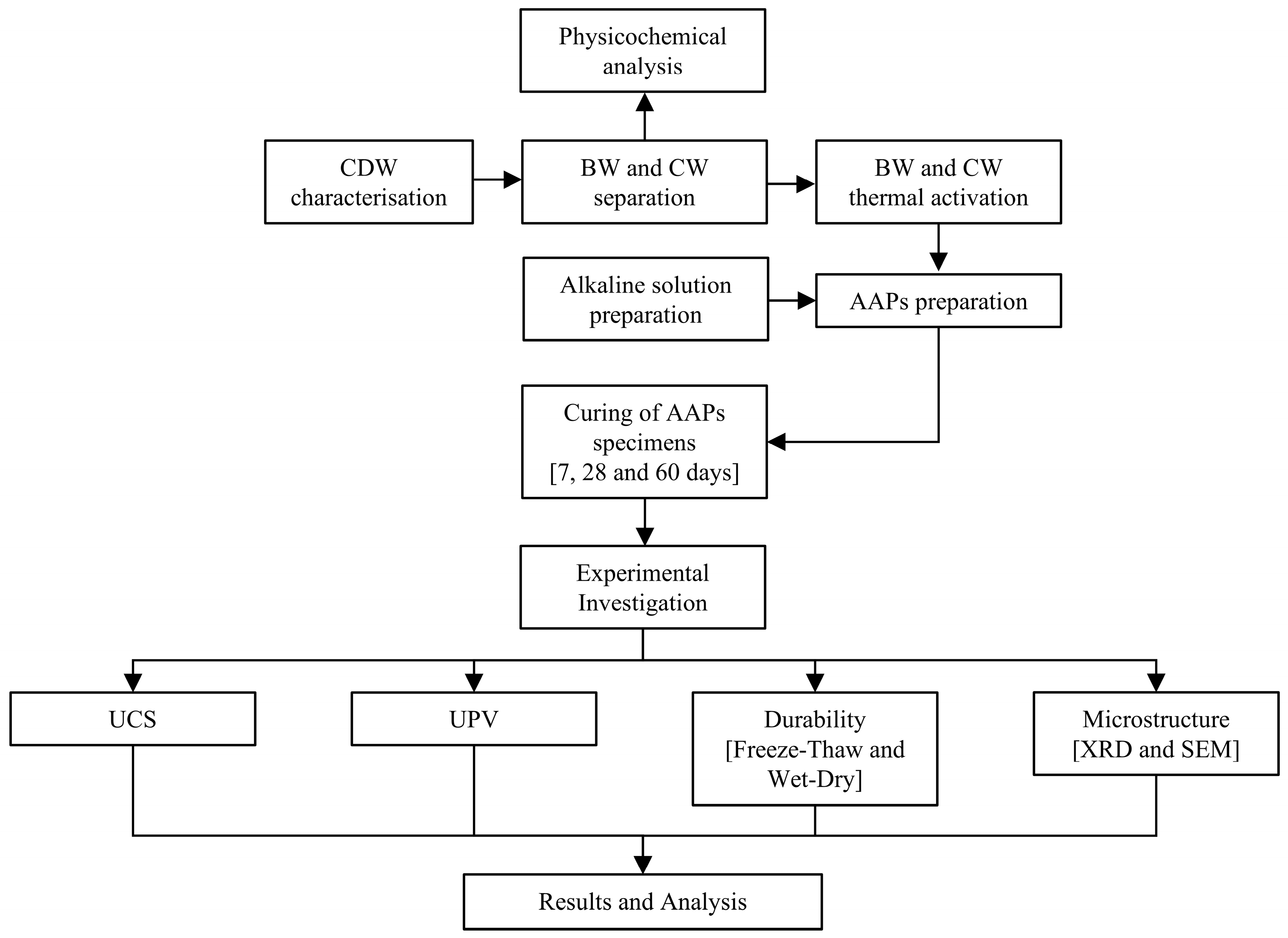

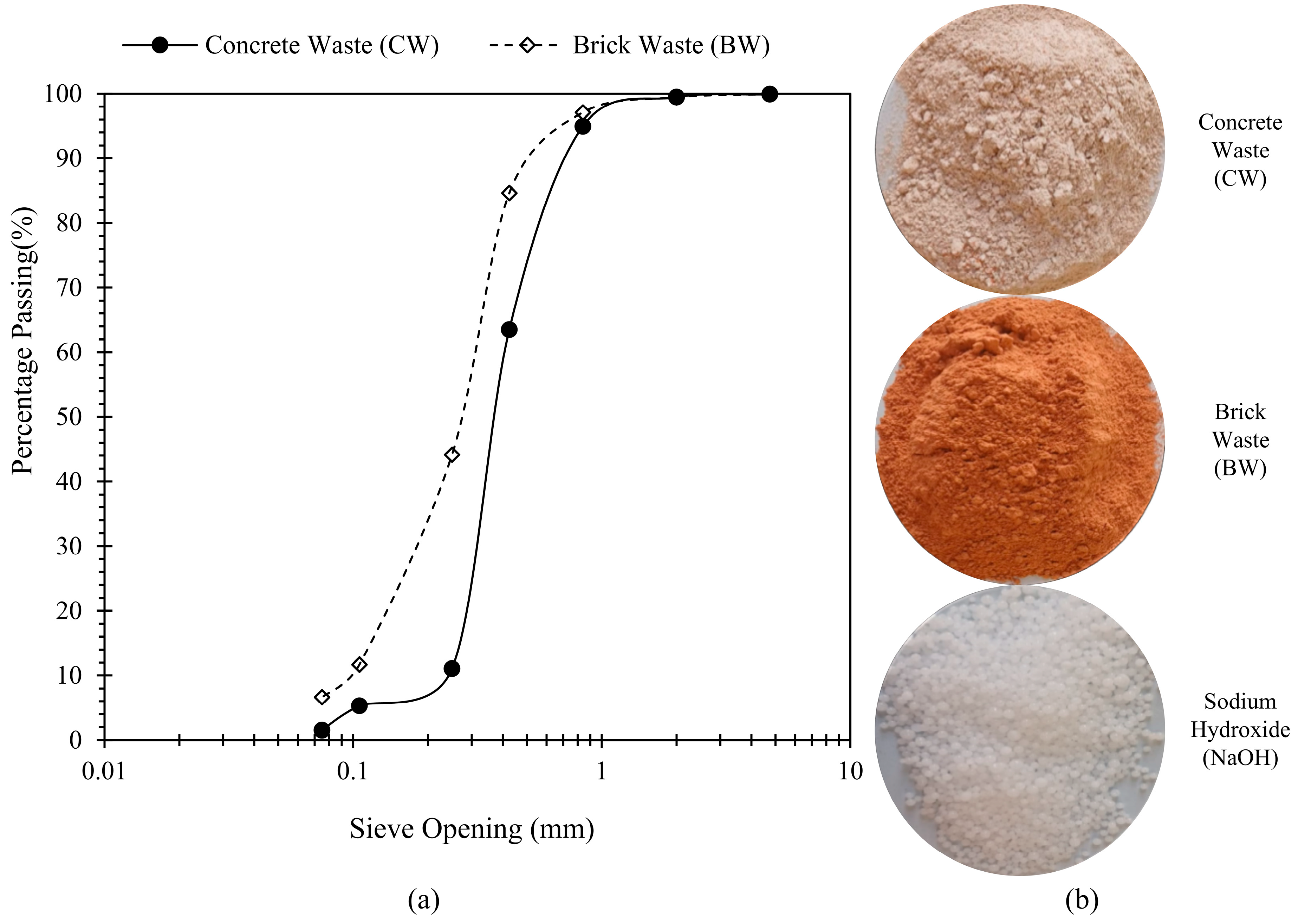
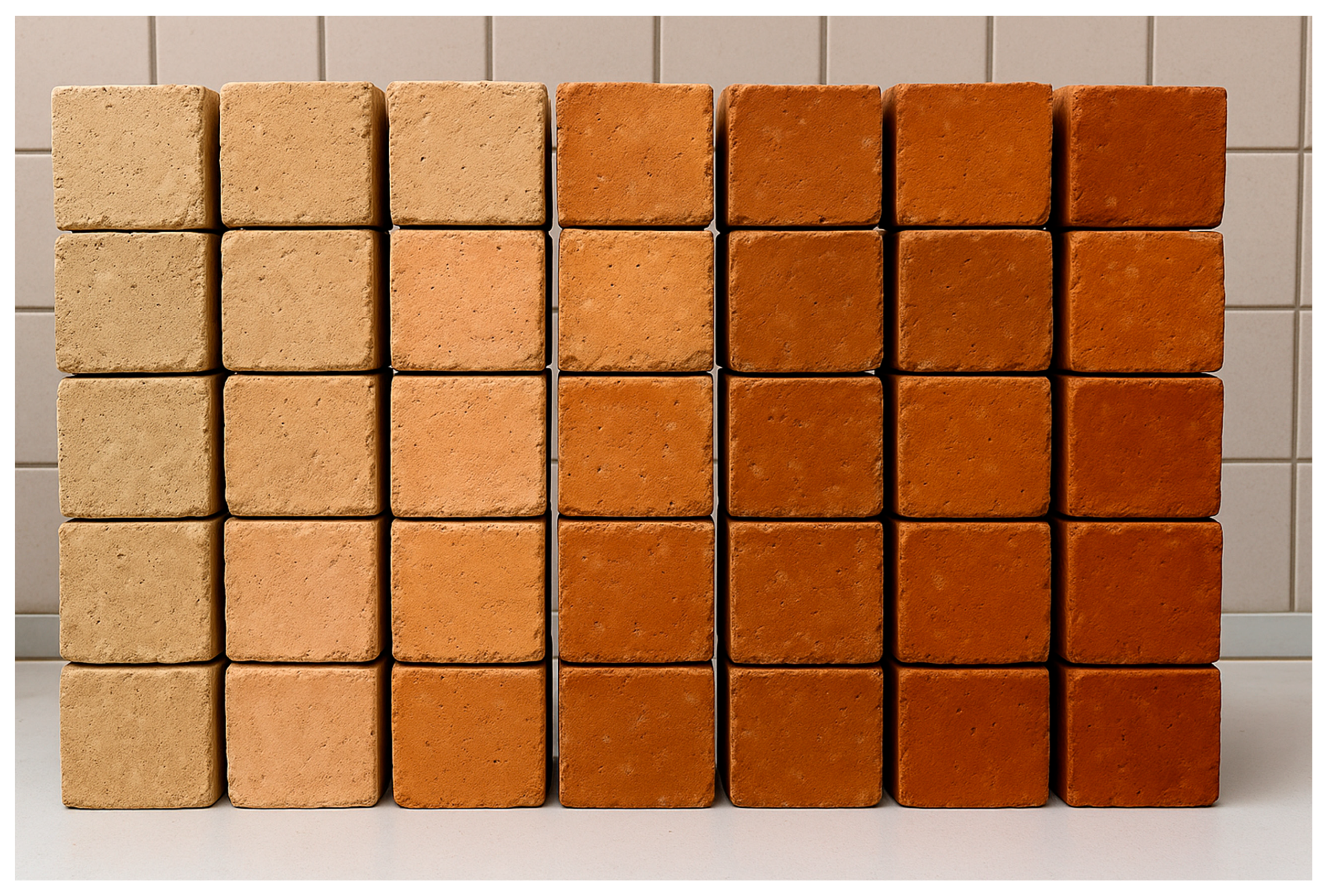
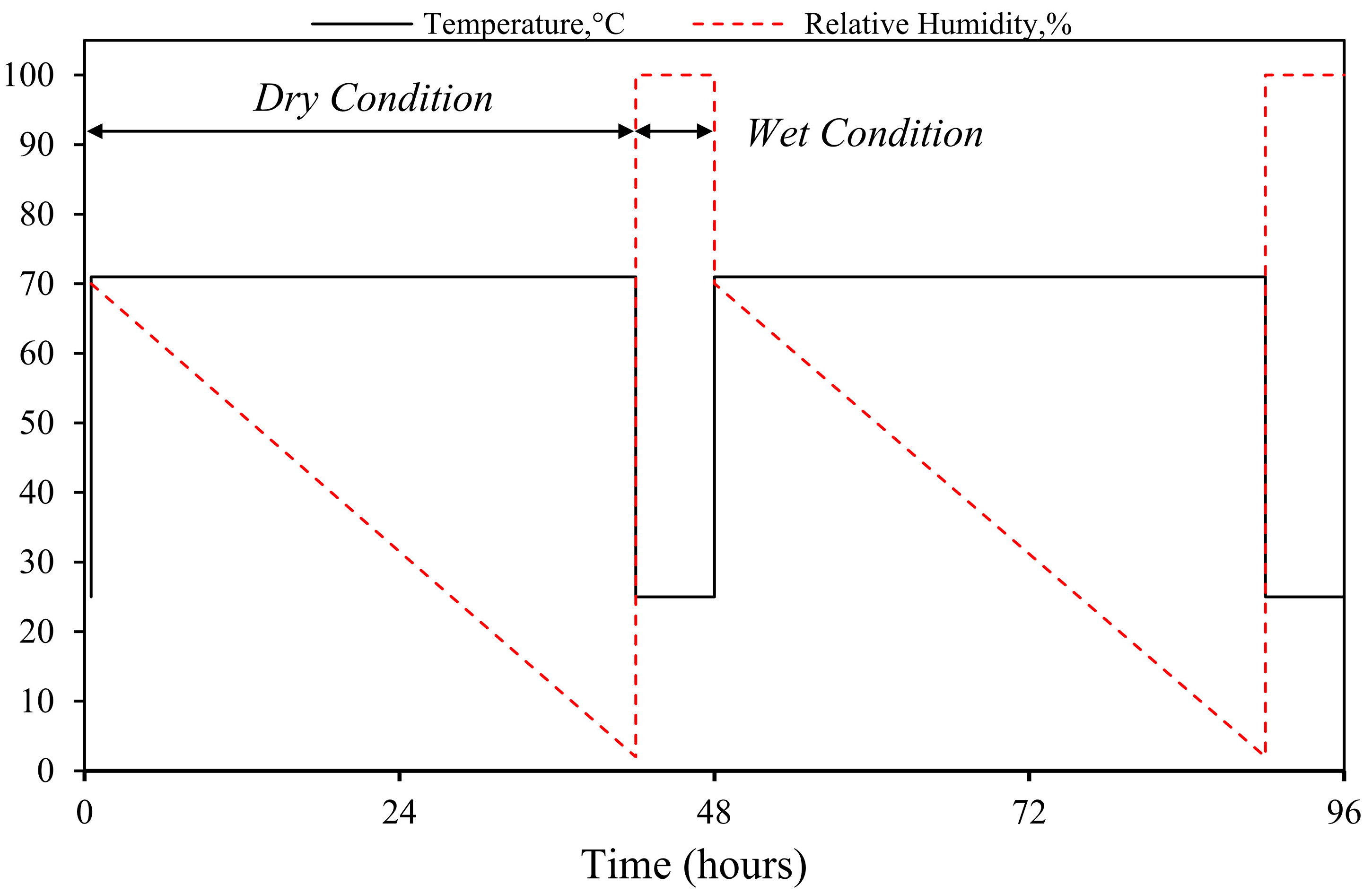


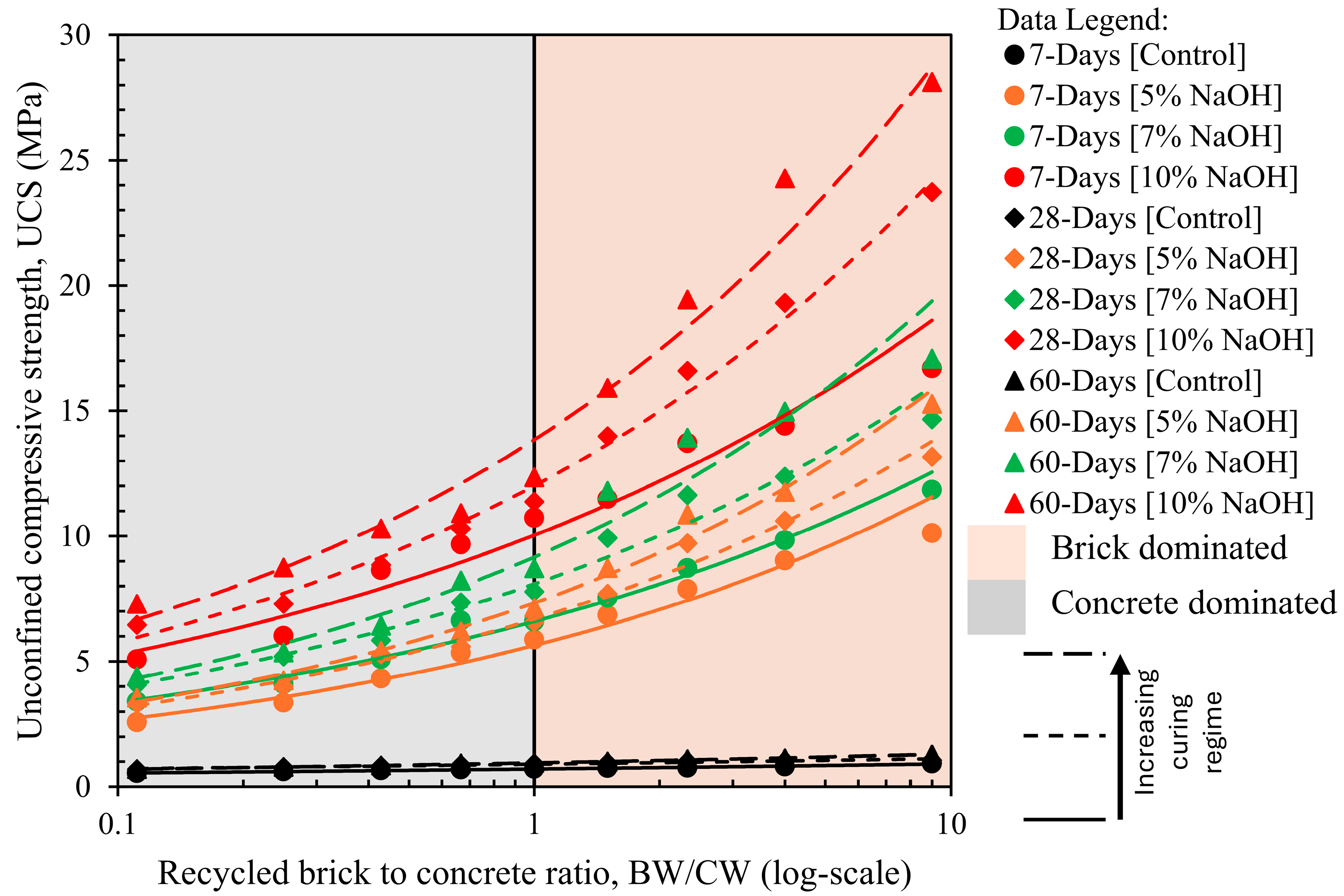
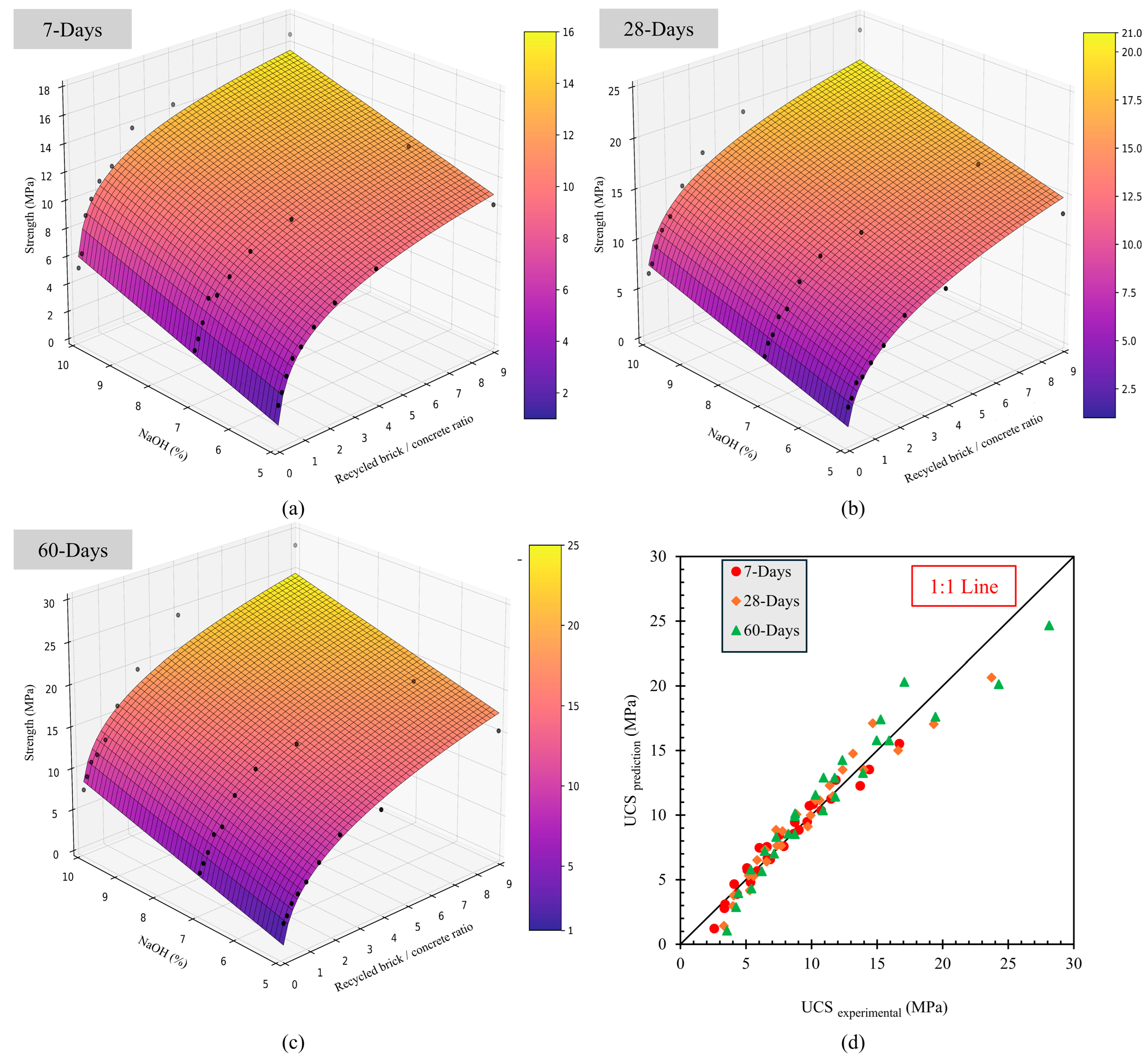

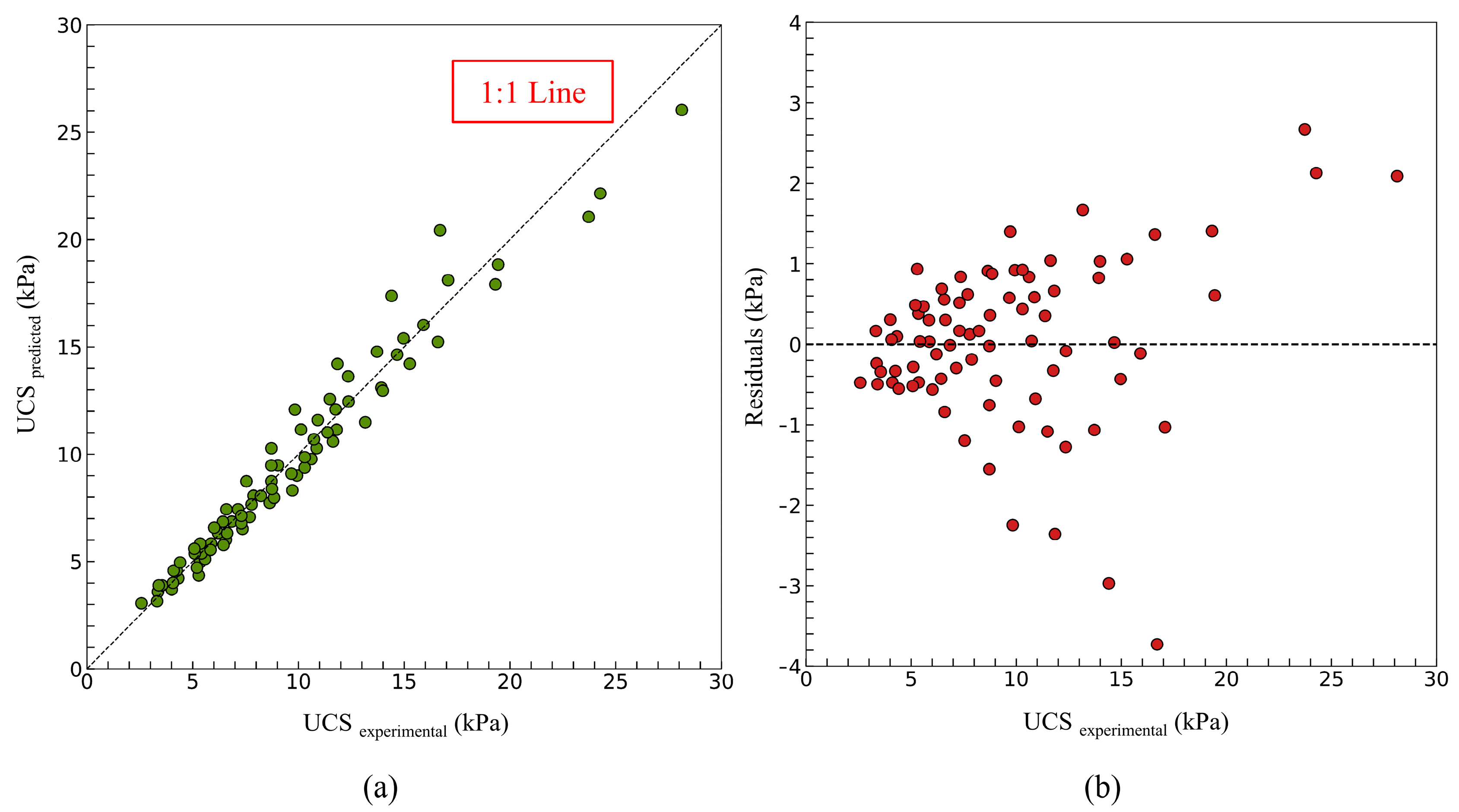
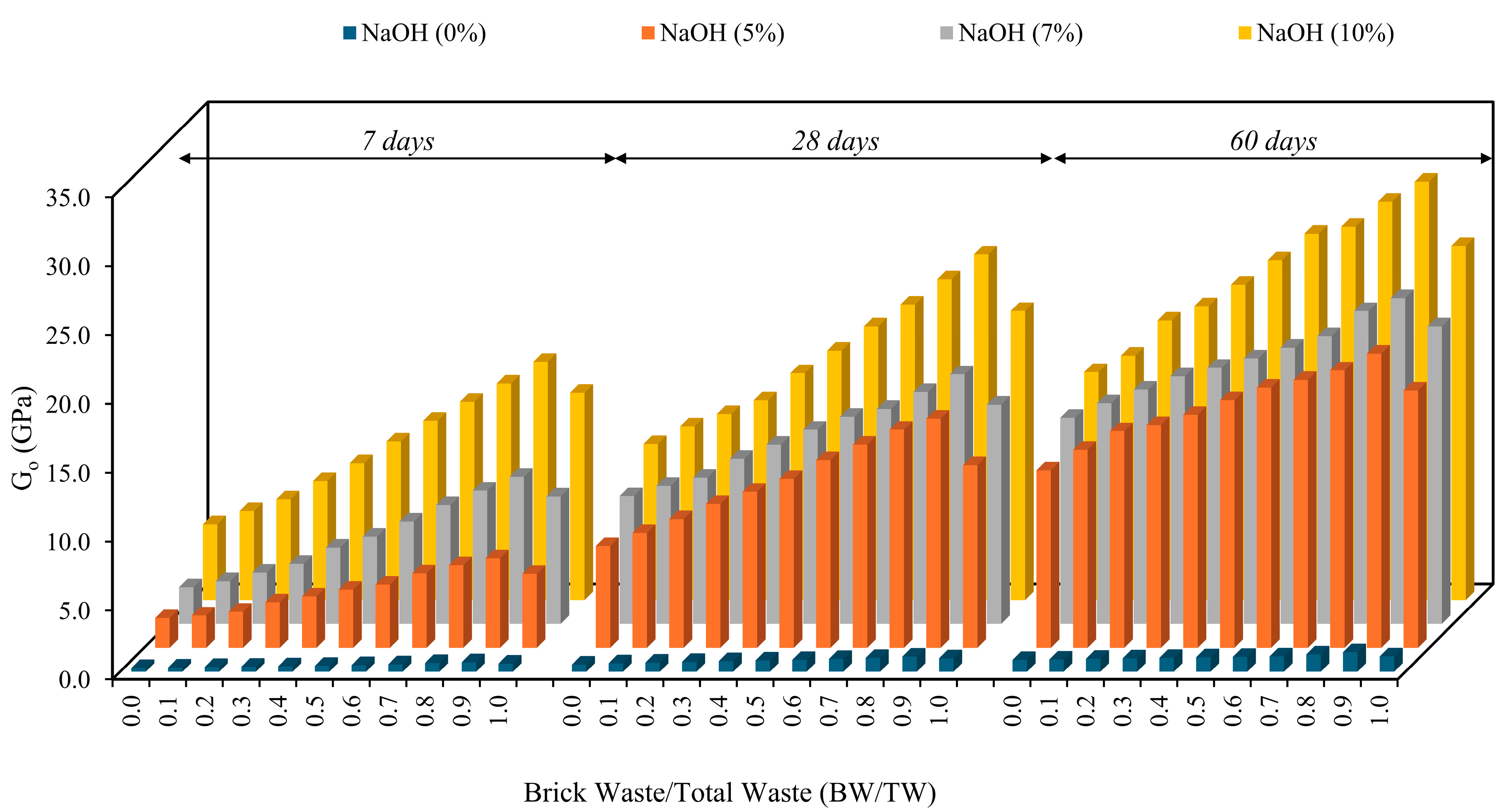




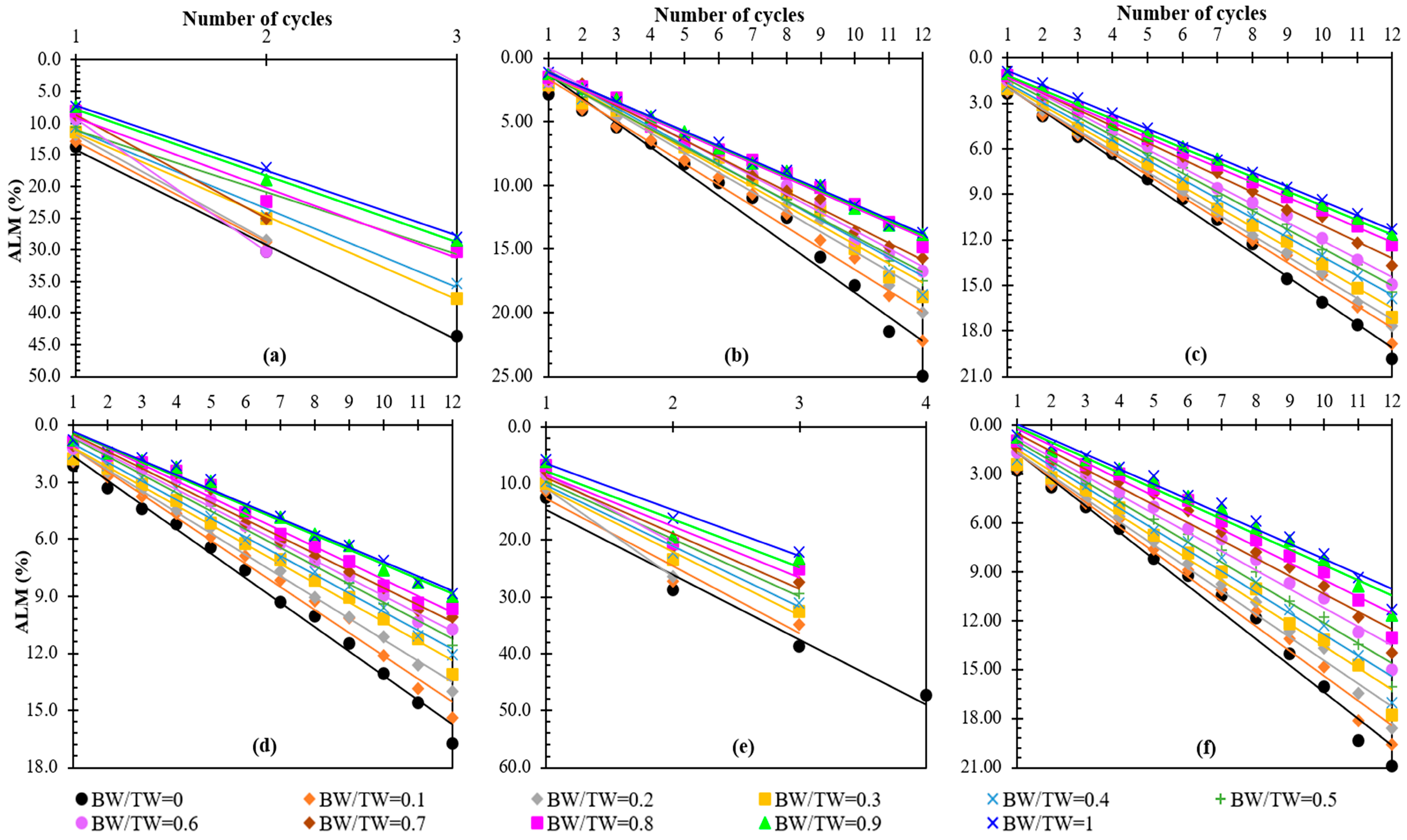

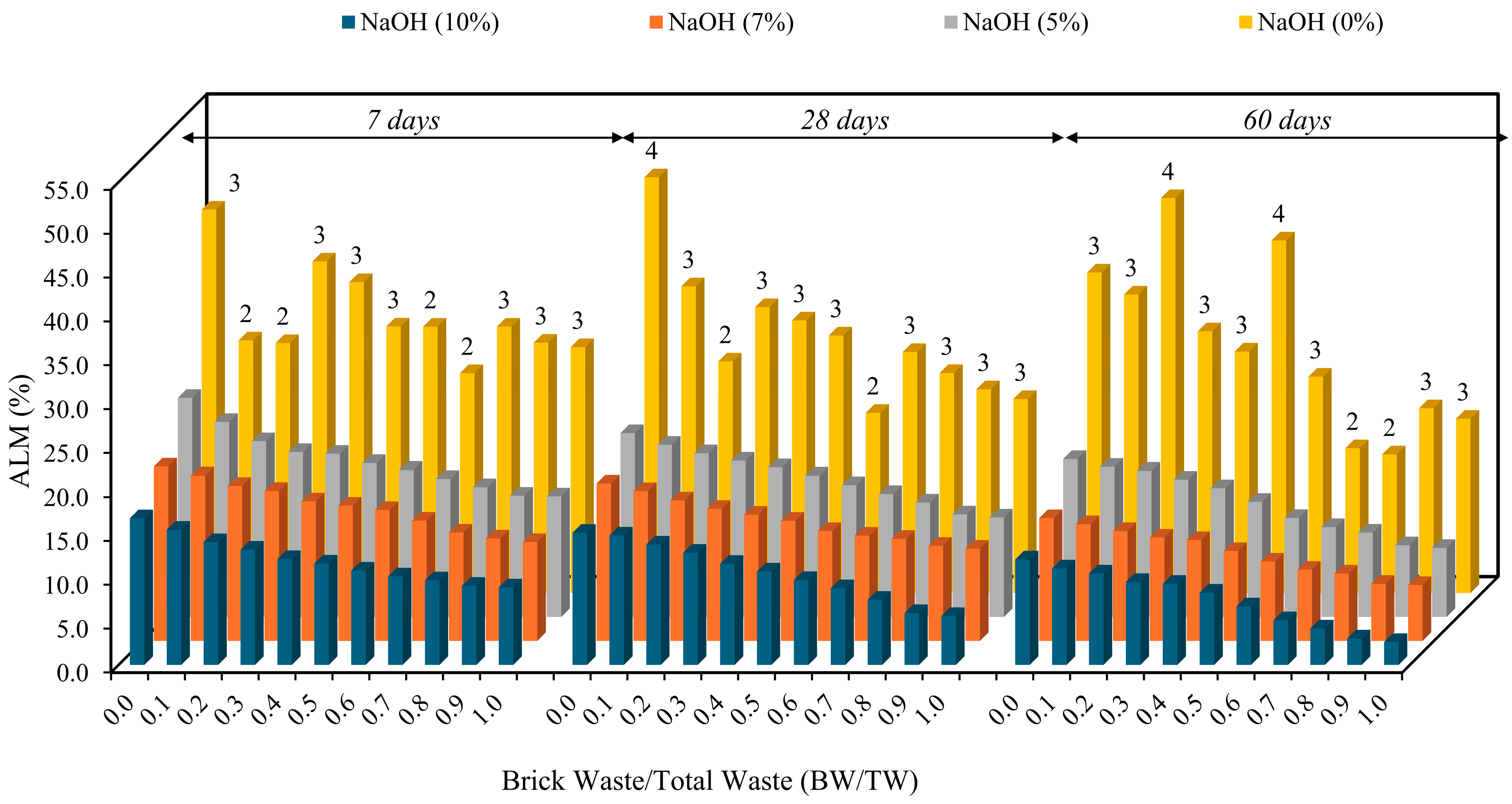

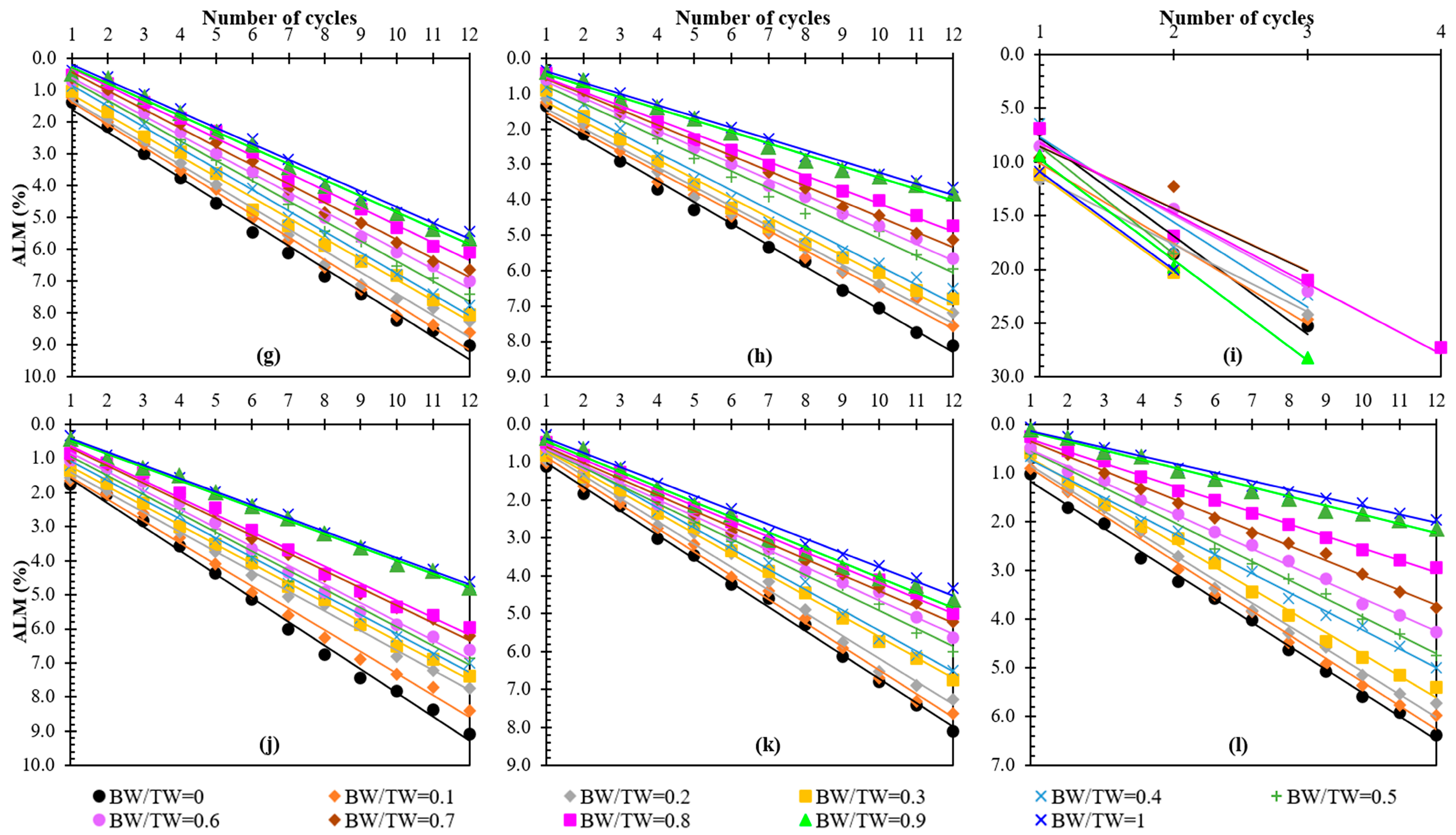
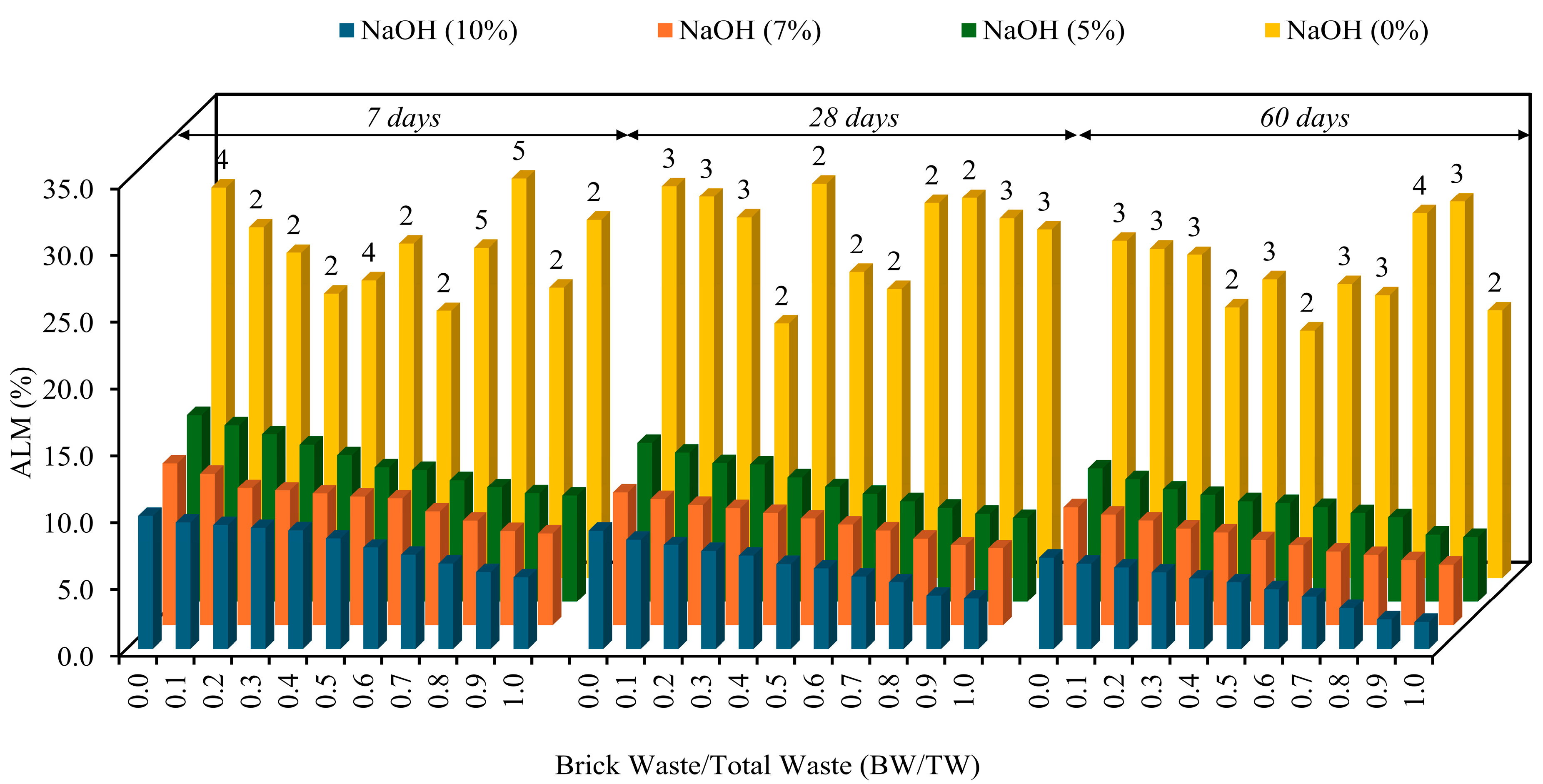
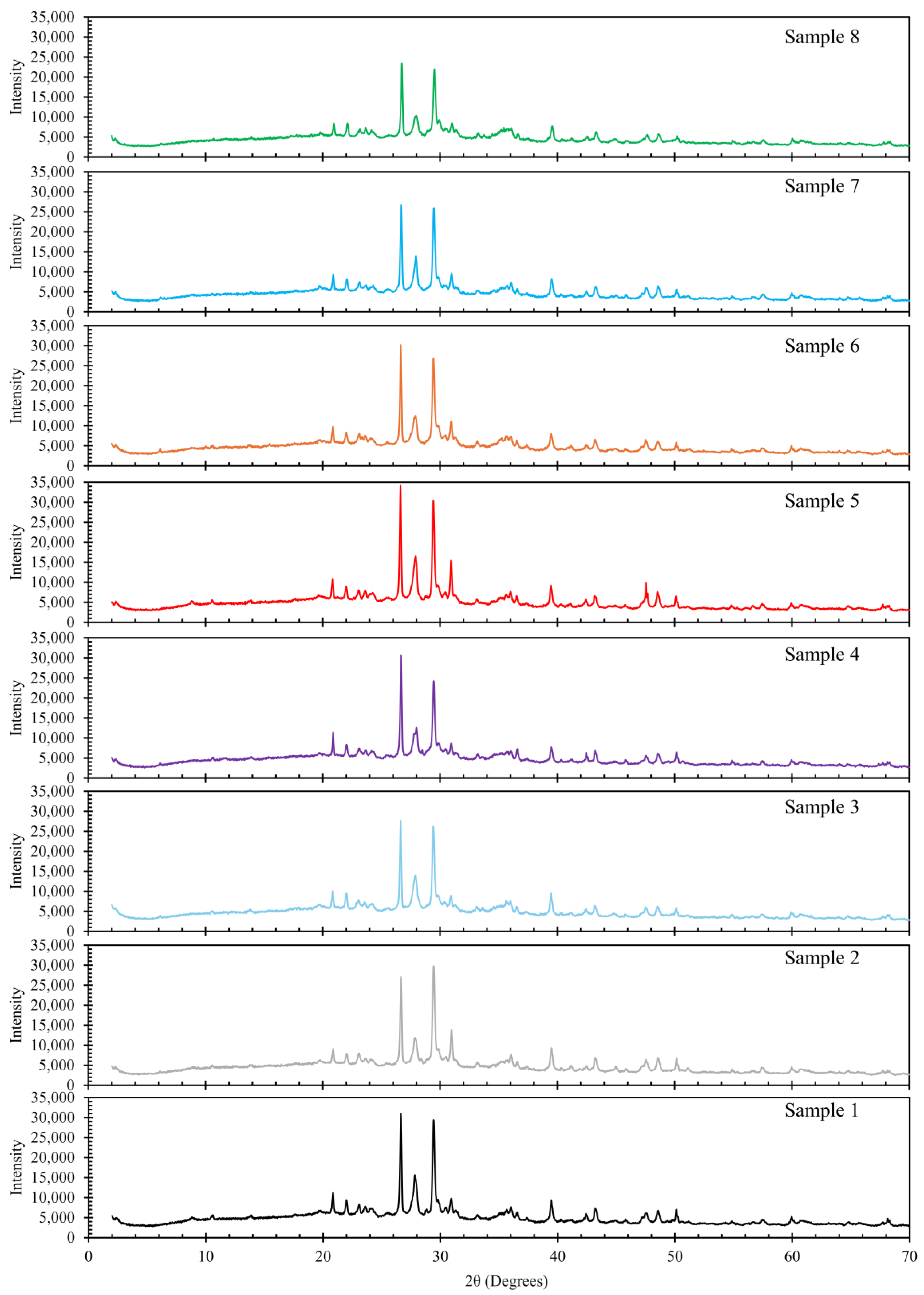




| Region | Material Type | Average Proportion (%) | Ref. | Region | Material Type | Average Proportion (%) | Ref. |
|---|---|---|---|---|---|---|---|
| EU | Concrete | ~30–50 | [26] | China | Concrete | ~40–50 | [27] |
| Bricks | ~10–25 | Brick | ~20–30 | ||||
| Wood | ~5–15 | Mortar | ~10–15 | ||||
| Germany | Concrete, bricks, tiles | ~60.00 | [28] | Spain | Concrete | ~30–40 | [27] |
| Wood, glass, plastic | ~5.00 | Brick | ~25–35 | ||||
| Bituminous and coal tar | ~20.00 | Mortar | ~15–20 | ||||
| Denmark | Concrete, bricks, tiles | ~50.00 | [28] | India | Brick and Masonry | ~30–35 | [22] |
| Wood, glass, plastic | ~5.00 | Concrete | ~25–30 | ||||
| Metals | ~17.00 | Soil, Sand and Gravel | ~30–40 | ||||
| Turkey | Concrete and Mortar | ~40–60 | [29] | UK | Concrete | ~25.00 | [30] |
| Masonry | ~20–30 | Asphalt | ~16.70 | ||||
| Wood | ~5–10 | Wood | ~8.30 | ||||
| Metals | ~12.50 |
| Material Property | Concrete Waste (CW) | Brick Waste (BW) |
|---|---|---|
| Gravel (%) | 0.08 | 0.08 |
| Sand (%) | 98.41 | 93.30 |
| Fines (%) | 1.51 | 6.62 |
| D10 | 0.26 | 0.1 |
| D30 | 0.31 | 0.19 |
| D60 | 0.41 | 0.3 |
| Cc | 0.90 | 1.20 |
| Cu | 1.58 | 3.00 |
| Specific Gravity, Gs | 2.48 | 2.14 |
| Oxides (%) | Brick Waste (BW) | Concrete Waste (CW) |
|---|---|---|
| CaO | 22.70 | 52.90 |
| SiO2 | 32.60 | 6.26 |
| Al2O3 | 10.50 | 1.79 |
| Fe2O3 | 7.59 | 1.09 |
| SO3 | 0.50 | 0.69 |
| MgO | 4.64 | 5.90 |
| K2O | 1.39 | 0.14 |
| CO2 | 17.90 | 30.70 |
| NaOH Content (%) | BW/TW Ratios Tested | Curing Ages (Days) | Specimens per Mix | Specimen Allocation per Mix | Total Specimens per NaOH Dosage |
|---|---|---|---|---|---|
| 0 | 0.0–1.0 (11 levels) * | 7, 28, 60 | 4 | 2 for UPV/UCS 1WD a; 1FT b | 132 |
| 5 | 0.0–1.0 (11 levels) | 7, 28, 60 | 4 | 2 for UPV/UCS 1WD; 1FT | 132 |
| 7 | 0.0–1.0 (11 levels) | 7, 28, 60 | 4 | 2 for UPV/UCS 1WD; 1FT | 132 |
| 10 | 0.0–1.0 (11 levels) | 7, 28, 60 | 4 | 2 for UPV/UCS 1WD; 1FT | 132 |
| Total | 528 | ||||
| Variable | Symbol | Units | Dimensions |
|---|---|---|---|
| Unconfined compressive strength | UCS | kPA | [M L−1 T−2] |
| Recycled concrete waste | CW | % (by mass) | --- |
| Recycled brick waste | BW | % (by mass) | --- |
| Alkali activator | NaOH | % (by mass) | --- |
| Curing regime | T | days | [T] |
| Curing Regime (Days) | α | β | λ | κ | R2 | RMSE |
|---|---|---|---|---|---|---|
| 7 | 32.39 | 0.06739 | 0.9367 | −31.40 | 0.9543 | 0.8161 |
| 28 | 12.25 | 0.23680 | 1.1780 | −11.75 | 0.9330 | 1.3470 |
| 60 | 13.98 | 0.25280 | 1.4500 | −14.22 | 0.9214 | 1.802 |
| Curing Regime (Days) | α | β | λ | κ | R2 | RMSE |
|---|---|---|---|---|---|---|
| 7 | 28.01 | 0.06749 | 1.474 | −31.43 | 0.9377 | 1.092 |
| 28 | 50.98 | 0.04721 | 1.187 | −44.86 | 0.9478 | 1.011 |
| 60 | 10.69 | 0.1907 | 1.312 | --- | 0.9334 | 1.107 |
| Variable | Symbol | Units | Dimensions |
|---|---|---|---|
| Shear Modulus | Go | GPA | [M L−1 T−2] |
| Recycled concrete | CW | % (by mass) | --- |
| Recycled brick | BW | % (by mass) | --- |
| Alkali activator | NaOH | % (by mass) | --- |
| Curing regime | T | days | [T] |
| Response Variable | Source | Sum of Squares | Degrees of Freedom (df) | Mean Square | F-Ratio | p-Value |
|---|---|---|---|---|---|---|
| Compressive Strength, UCS (MPa) | A: BW/TW | 2607.87 | 10 | 260.79 | 595.97 | 0.000 |
| B: Curing Period (Days) | 264.21 | 2 | 132.11 | 301.9 | 0.000 | |
| C: NaOH Content (%) | 4861.18 | 3 | 1620.39 | 3703.08 | 0.000 | |
| AB | 137.54 | 20 | 6.88 | 15.72 | 0.000 | |
| AC | 1046.27 | 30 | 34.88 | 79.7 | 0.000 | |
| BC | 119.91 | 6 | 19.99 | 45.67 | 0.000 | |
| ABC | 95.06 | 60 | 1.58 | 3.62 | 0.000 | |
| Residual | 57.76 | 132 | 0.44 | |||
| Total (Corrected) | 9189.8 | 263 | ||||
| Initial Shear Modulus, Go (GPa) | A: BW/TW | 1406.29 | 10 | 140.63 | 1067.89 | 0.000 |
| B: Curing Period (Days) | 4258 | 2 | 2129 | 16,166.93 | 0.000 | |
| C: NaOH Content (%) | 10,166.4 | 3 | 3388.8 | 25,733.45 | 0.000 | |
| AB | 20.66 | 20 | 1.03 | 7.84 | 0.000 | |
| AC | 546.7 | 30 | 18.22 | 138.38 | 0.000 | |
| BC | 1258.97 | 6 | 209.83 | 1593.37 | 0.000 | |
| ABC | 24.52 | 60 | 0.41 | 3.1 | 0.000 | |
| Residual | 17.38 | 132 | 0.13 | |||
| Total (Corrected) | 17,698.9 | 263 | ||||
| Wet–Dry Accumulated Mass Loss (%) | A: BW/TW | 230.89 | 10 | 23.09 | 27.31 | 0.000 |
| B: NaOH Content (%) | 7341.32 | 3 | 2447.11 | 2894.02 | 0.000 | |
| C: Curing Period (Days) | 184.35 | 2 | 92.18 | 109.01 | 0.000 | |
| AB | 219.08 | 30 | 7.3 | 8.64 | 0.000 | |
| AC | 15.96 | 20 | 0.8 | 0.94 | 0.038 | |
| BC | 31.53 | 6 | 5.25 | 6.21 | 0.000 | |
| ABC | 50.73 | 60 | 0.85 | 2.58 | 0.056 | |
| Residual | 0 | 0 | ||||
| Total (Corrected) | 8073.86 | 131 | ||||
| Freeze–Thaw Accumulated Mass Loss (%) | A: BW/TW | 1599.33 | 10 | 159.93 | 54.07 | 0.000 |
| B: NaOH Content (%) | 6592.5 | 3 | 2197.5 | 742.89 | 0.000 | |
| C: Curing Period (Days) | 632.32 | 2 | 316.16 | 106.88 | 0.000 | |
| AB | 340.18 | 30 | 11.34 | 3.83 | 0.000 | |
| AC | 64.83 | 20 | 3.24 | 1.1 | 0.048 | |
| BC | 12.78 | 6 | 2.13 | 0.72 | 0.055 | |
| ABC | 177.48 | 60 | 2.96 | 1.39 | 0.068 | |
| Residual | 0 | 0 | ||||
| Total (Corrected) | 9419.42 | 131 | ||||
Disclaimer/Publisher’s Note: The statements, opinions and data contained in all publications are solely those of the individual author(s) and contributor(s) and not of MDPI and/or the editor(s). MDPI and/or the editor(s) disclaim responsibility for any injury to people or property resulting from any ideas, methods, instructions or products referred to in the content. |
© 2025 by the authors. Licensee MDPI, Basel, Switzerland. This article is an open access article distributed under the terms and conditions of the Creative Commons Attribution (CC BY) license (https://creativecommons.org/licenses/by/4.0/).
Share and Cite
Javed, I.; Saeed, H.; Ekinci, A. Transforming Construction Waste into High-Performance Alkali-Activated Paste with Microstructural and Predictive π Modelling Insights. Buildings 2025, 15, 3830. https://doi.org/10.3390/buildings15213830
Javed I, Saeed H, Ekinci A. Transforming Construction Waste into High-Performance Alkali-Activated Paste with Microstructural and Predictive π Modelling Insights. Buildings. 2025; 15(21):3830. https://doi.org/10.3390/buildings15213830
Chicago/Turabian StyleJaved, Israf, Hamza Saeed, and Abdullah Ekinci. 2025. "Transforming Construction Waste into High-Performance Alkali-Activated Paste with Microstructural and Predictive π Modelling Insights" Buildings 15, no. 21: 3830. https://doi.org/10.3390/buildings15213830
APA StyleJaved, I., Saeed, H., & Ekinci, A. (2025). Transforming Construction Waste into High-Performance Alkali-Activated Paste with Microstructural and Predictive π Modelling Insights. Buildings, 15(21), 3830. https://doi.org/10.3390/buildings15213830






